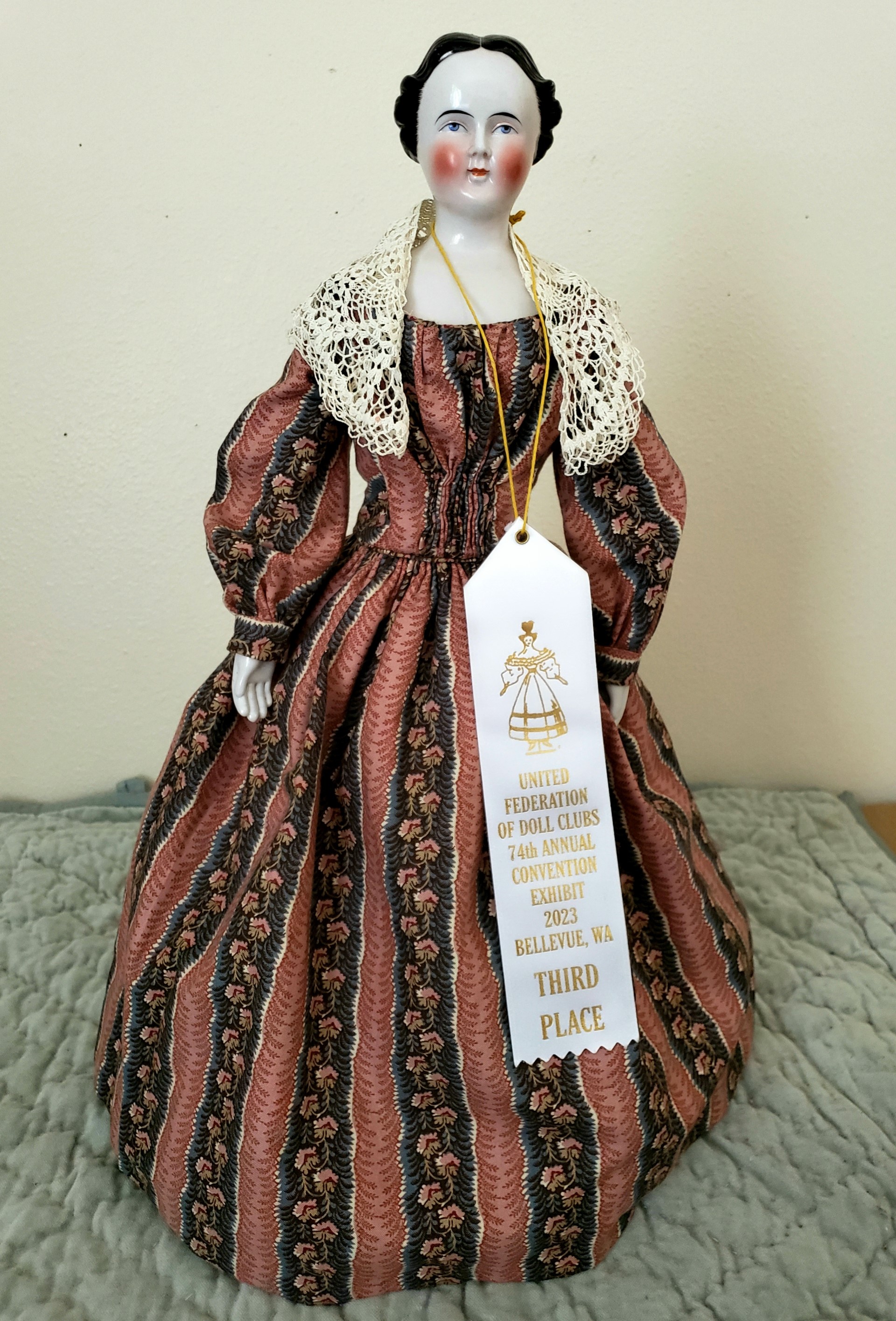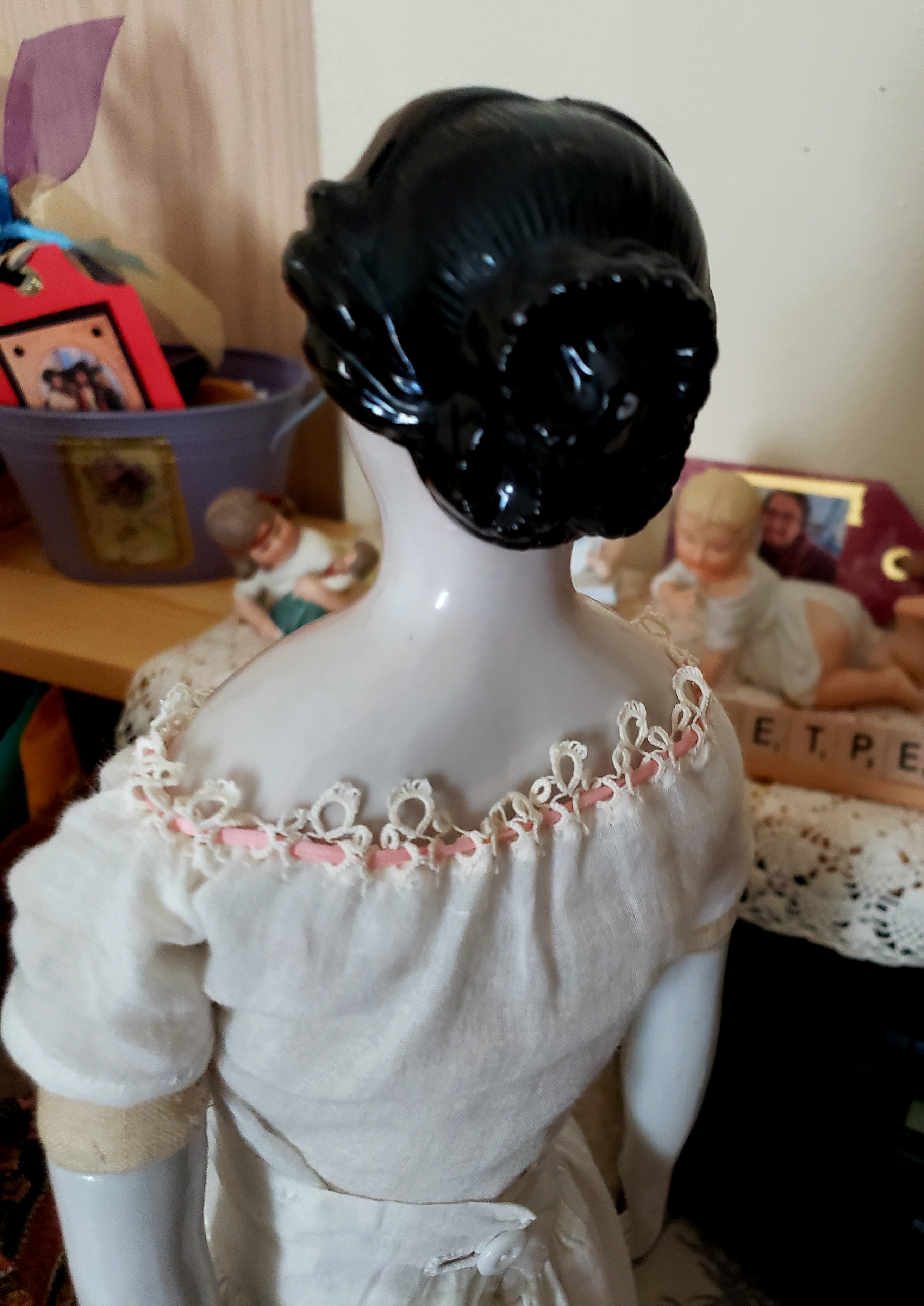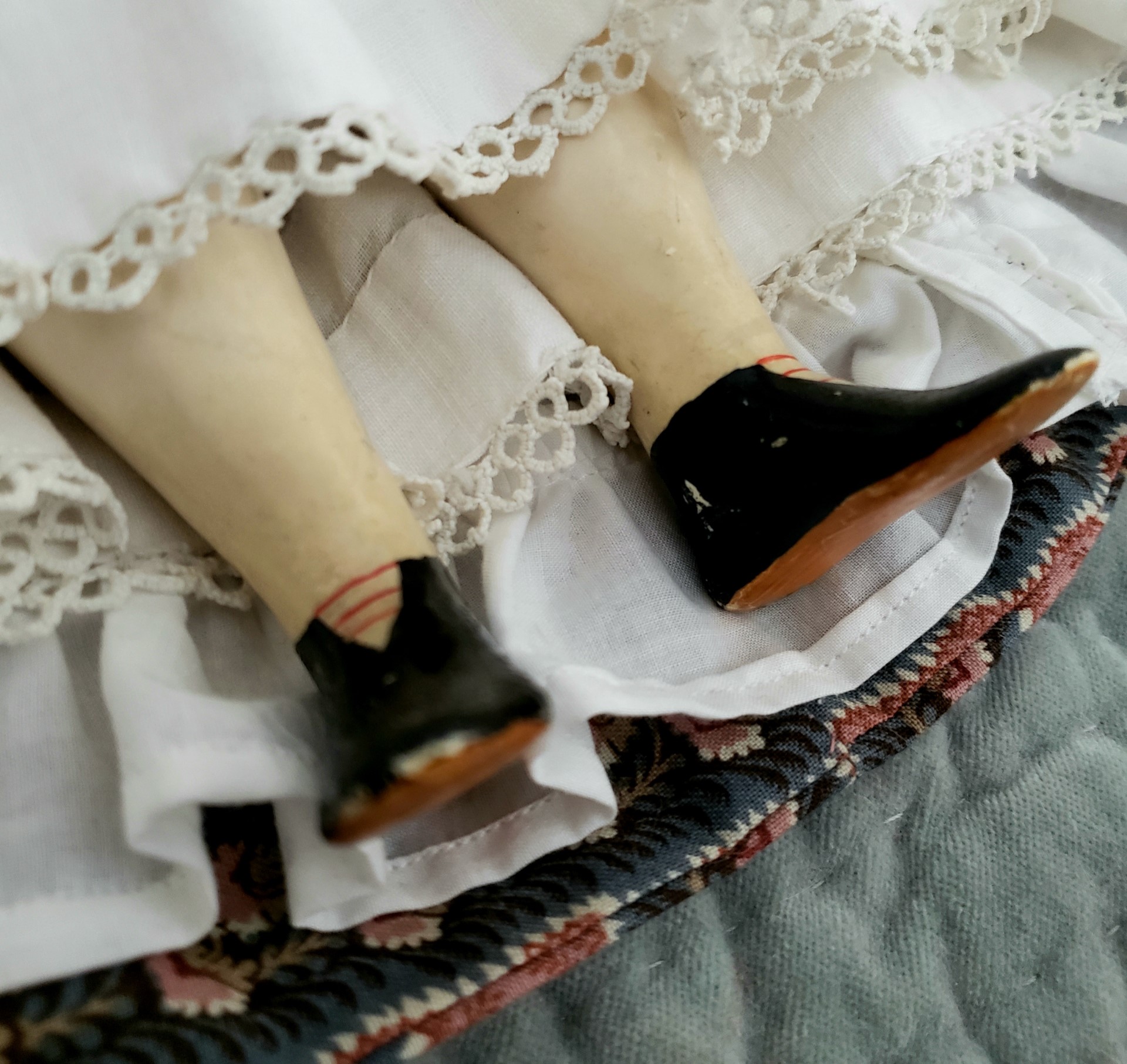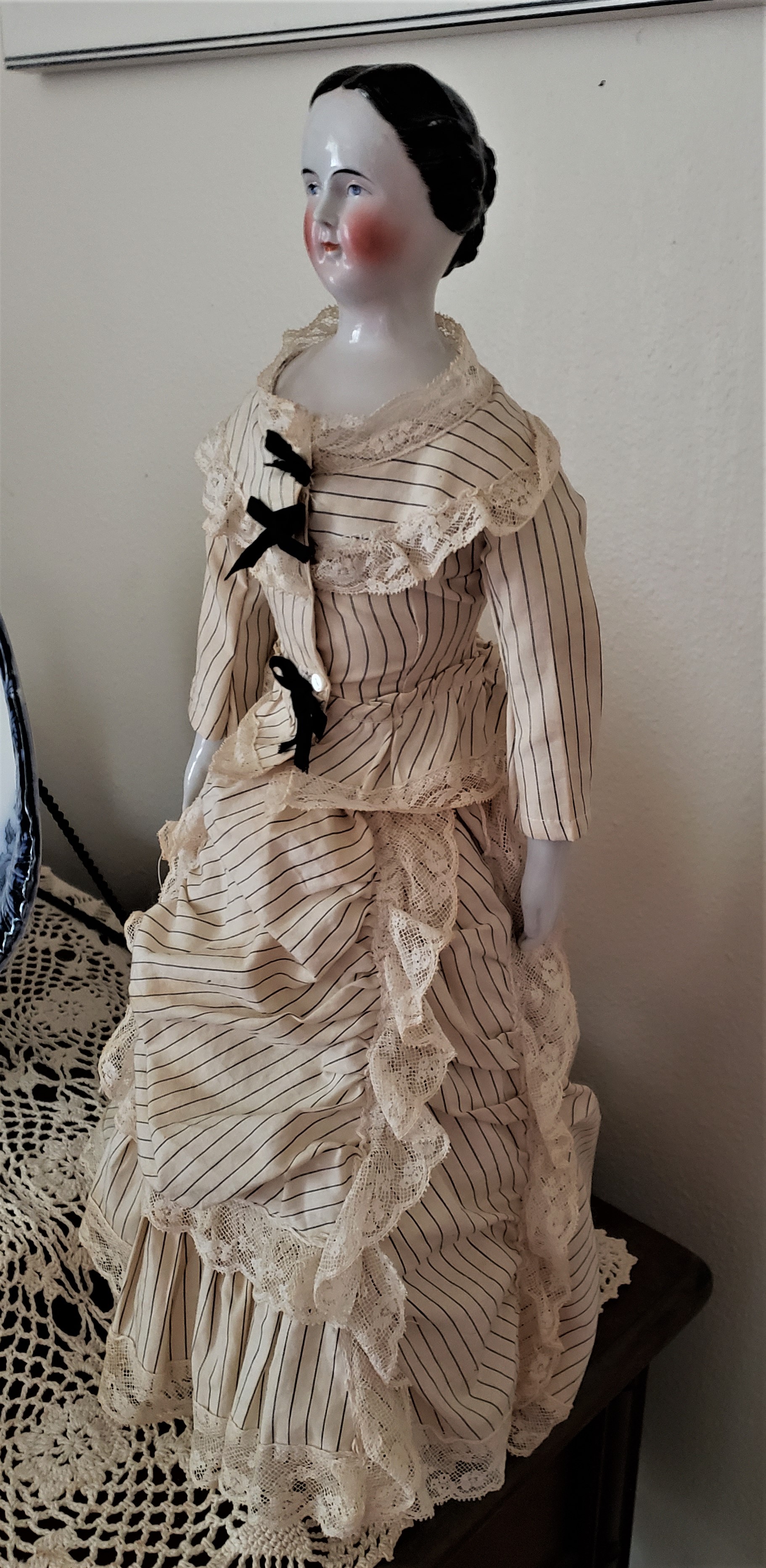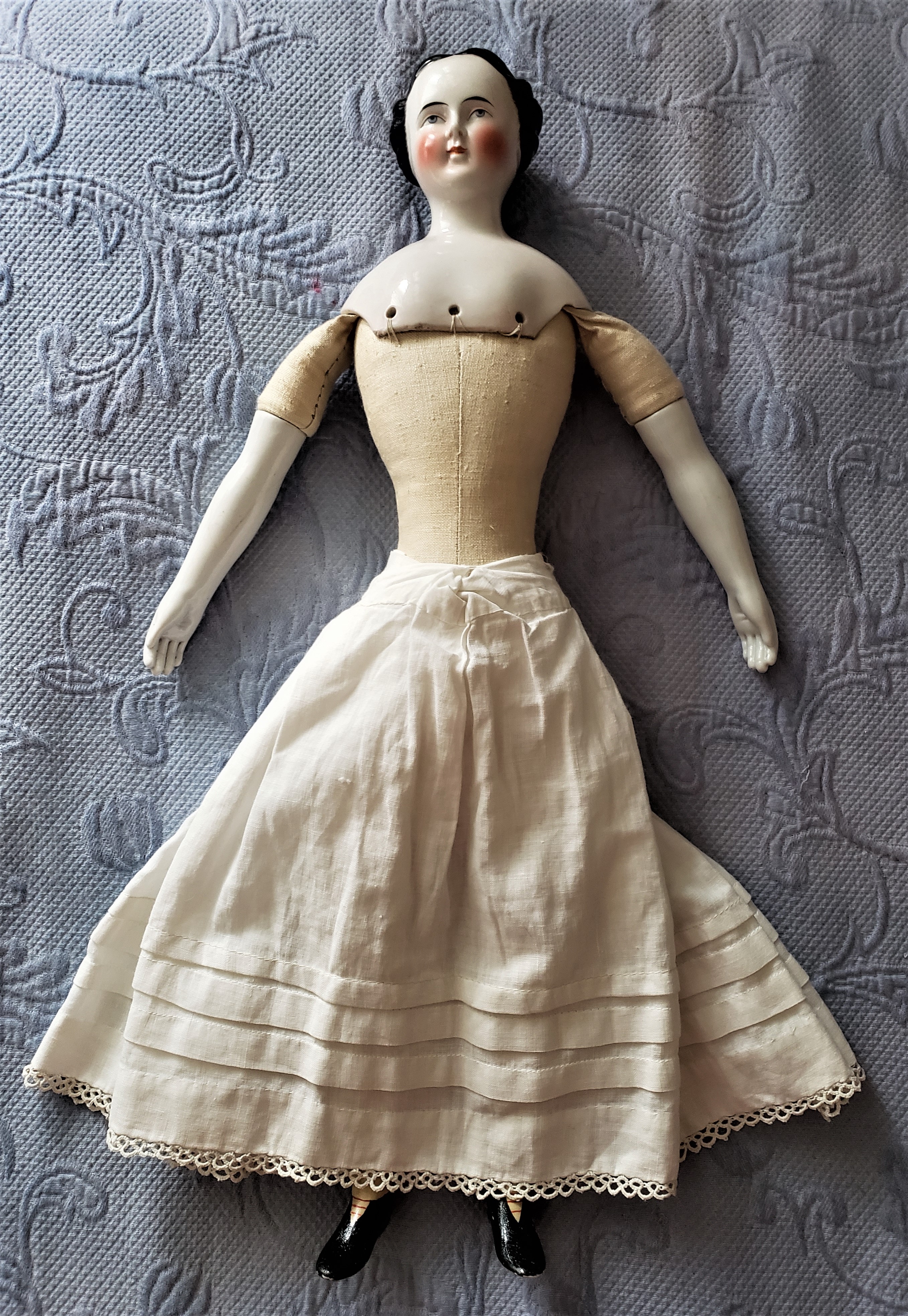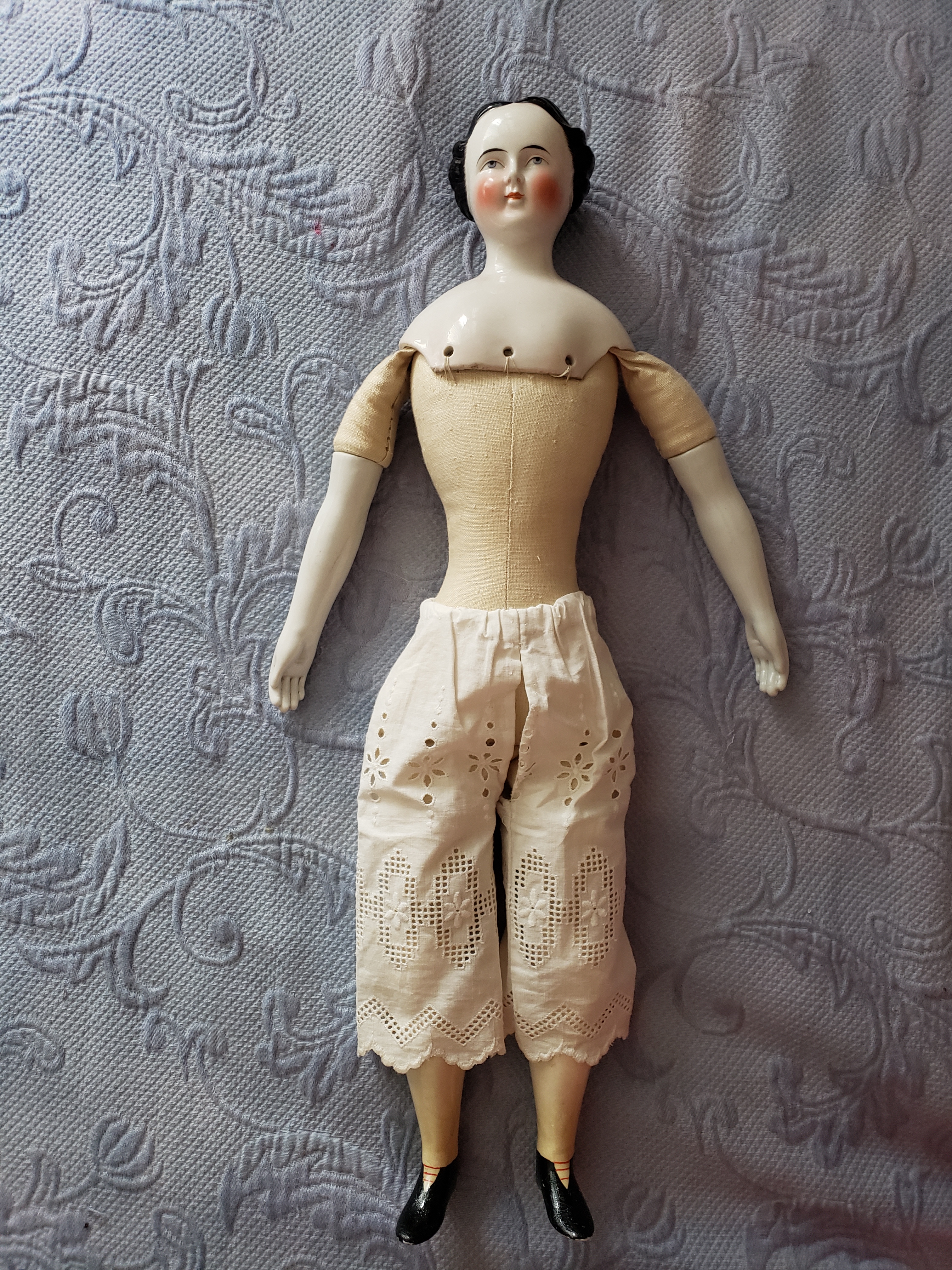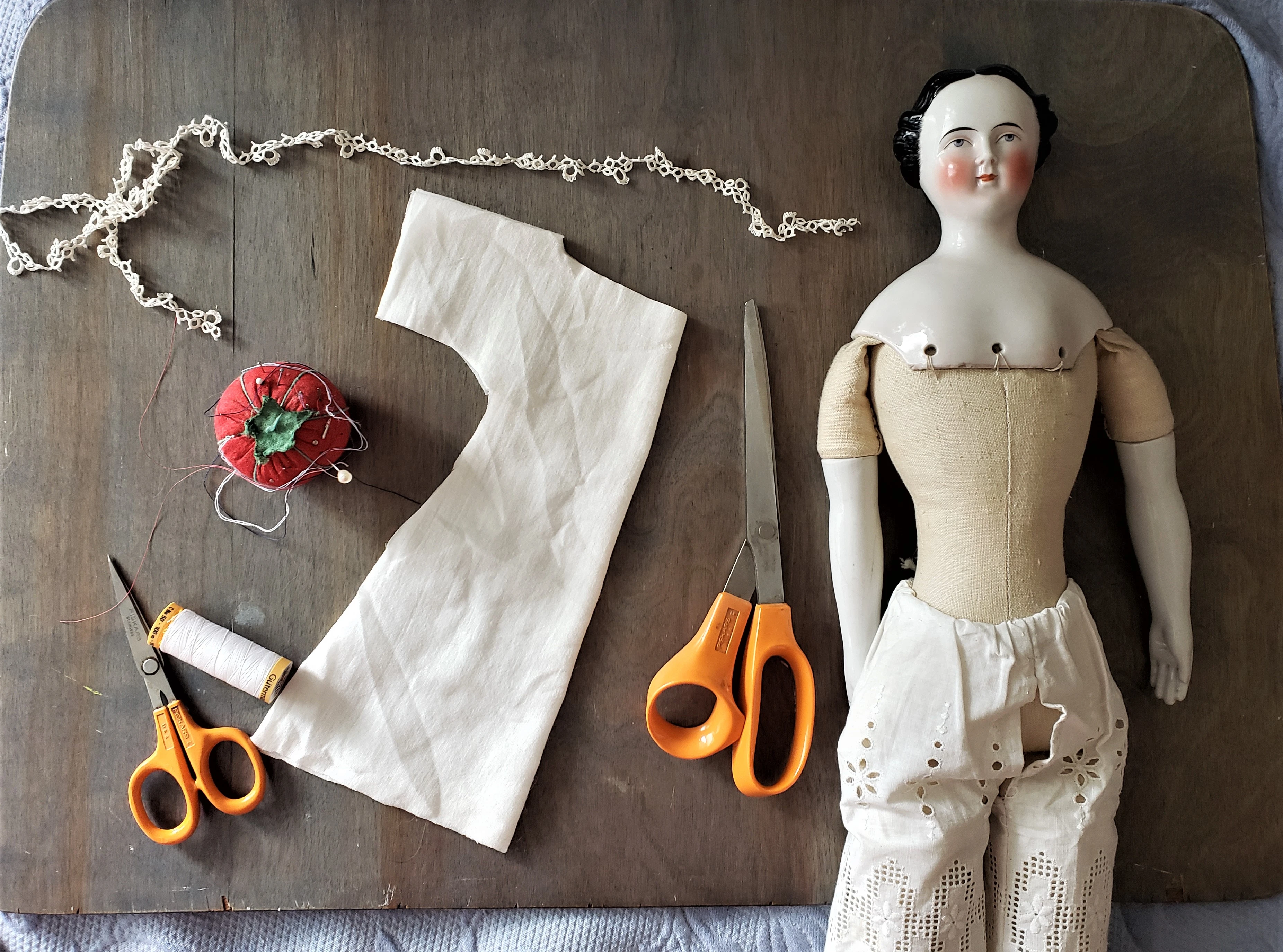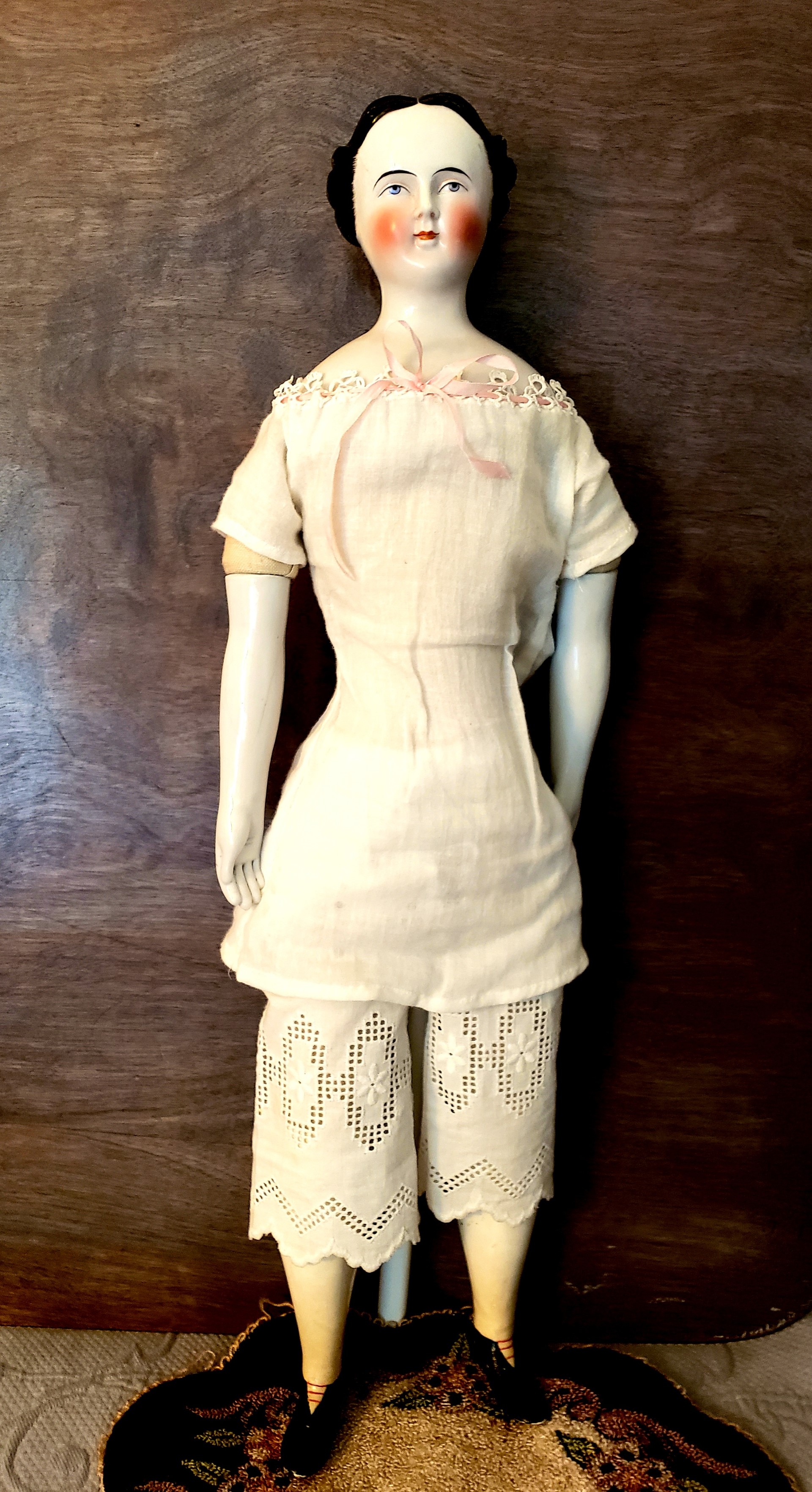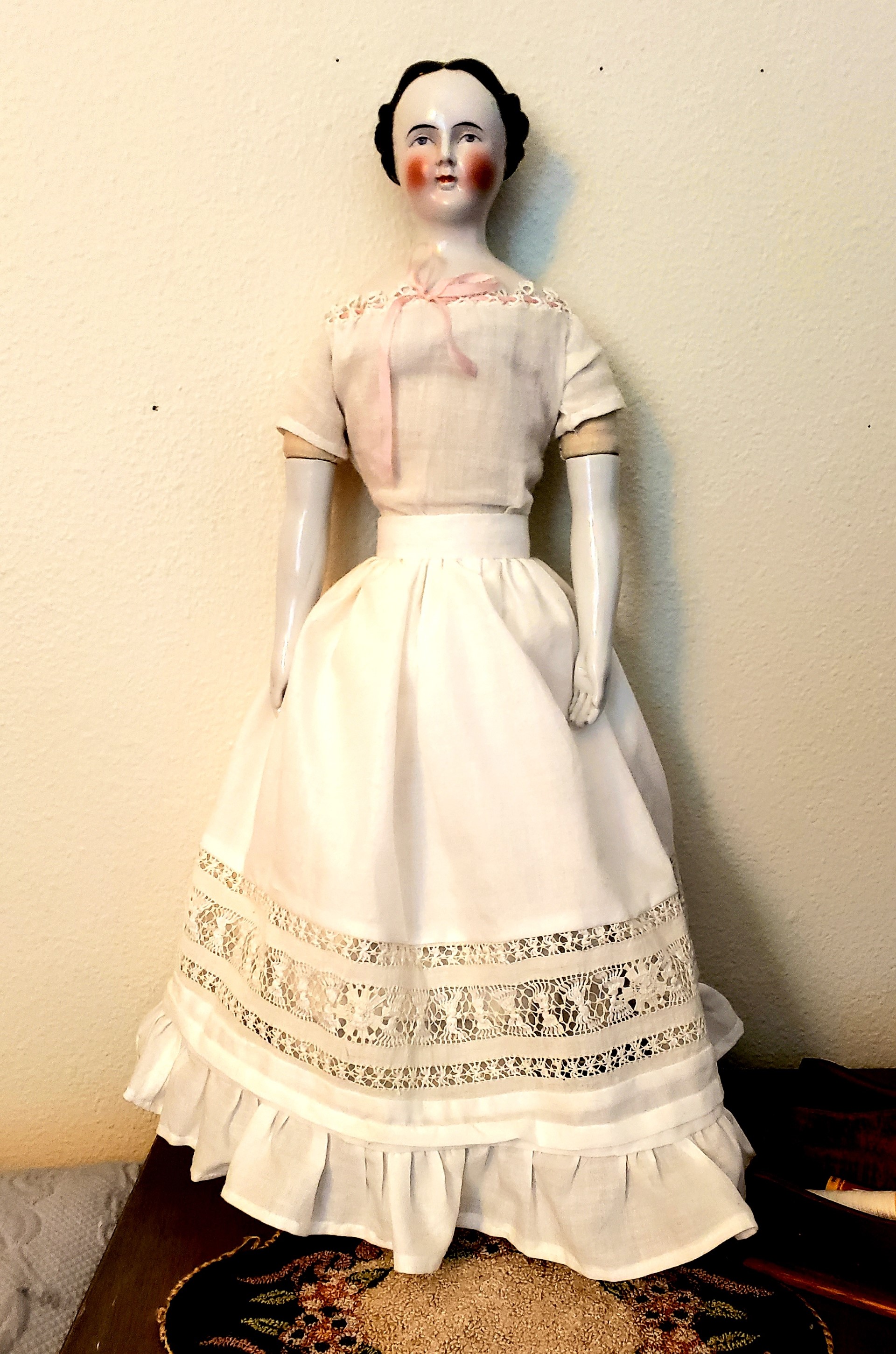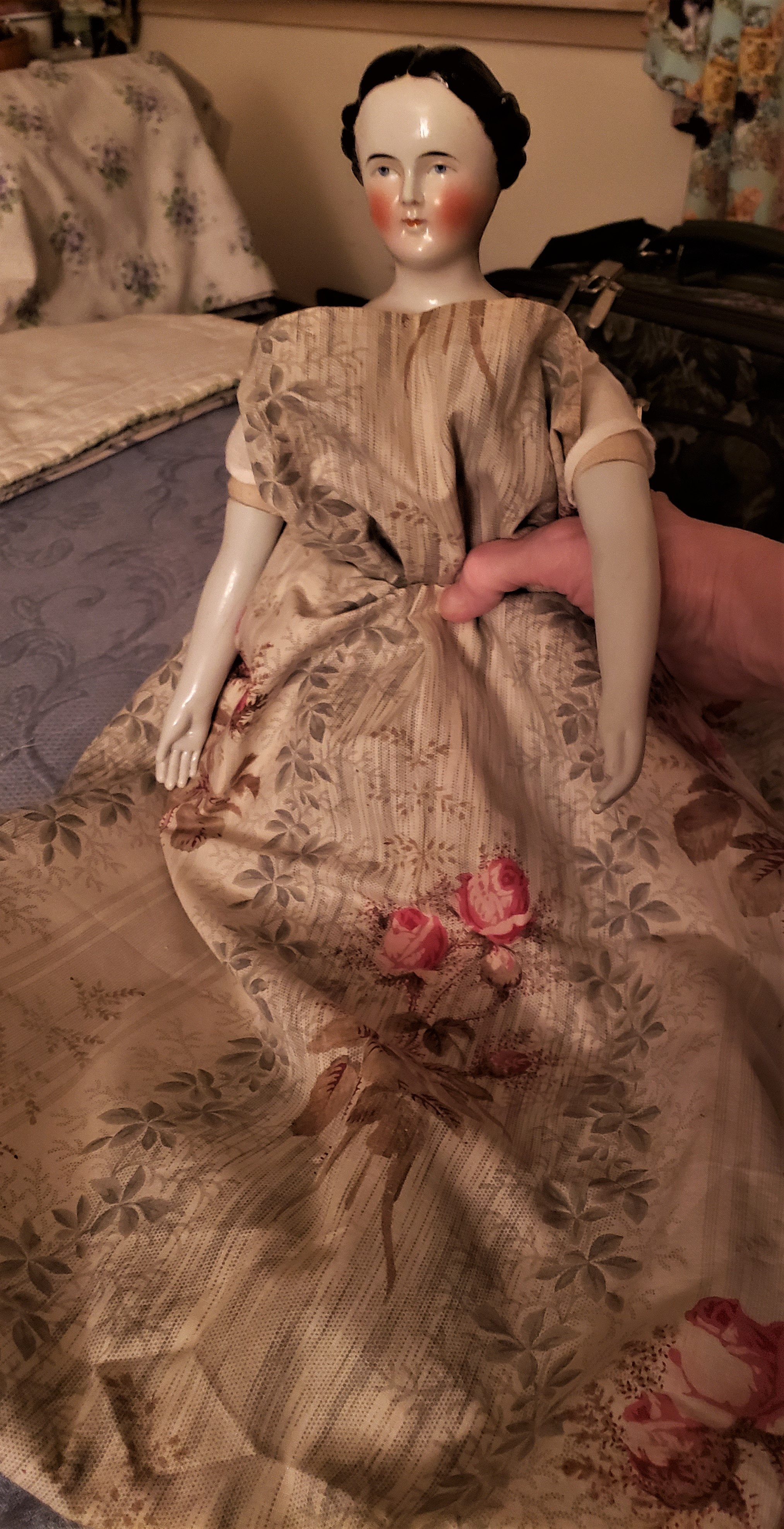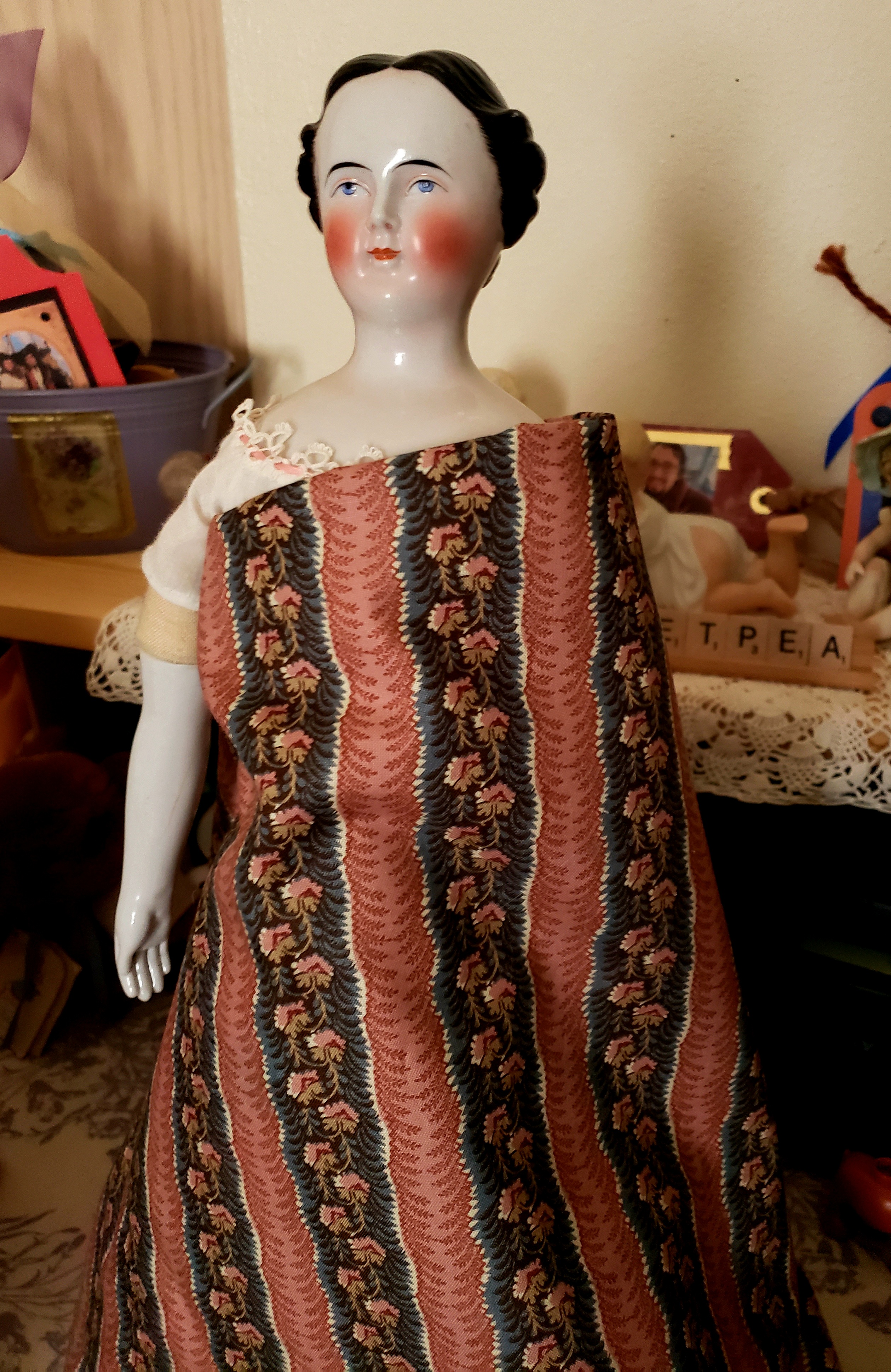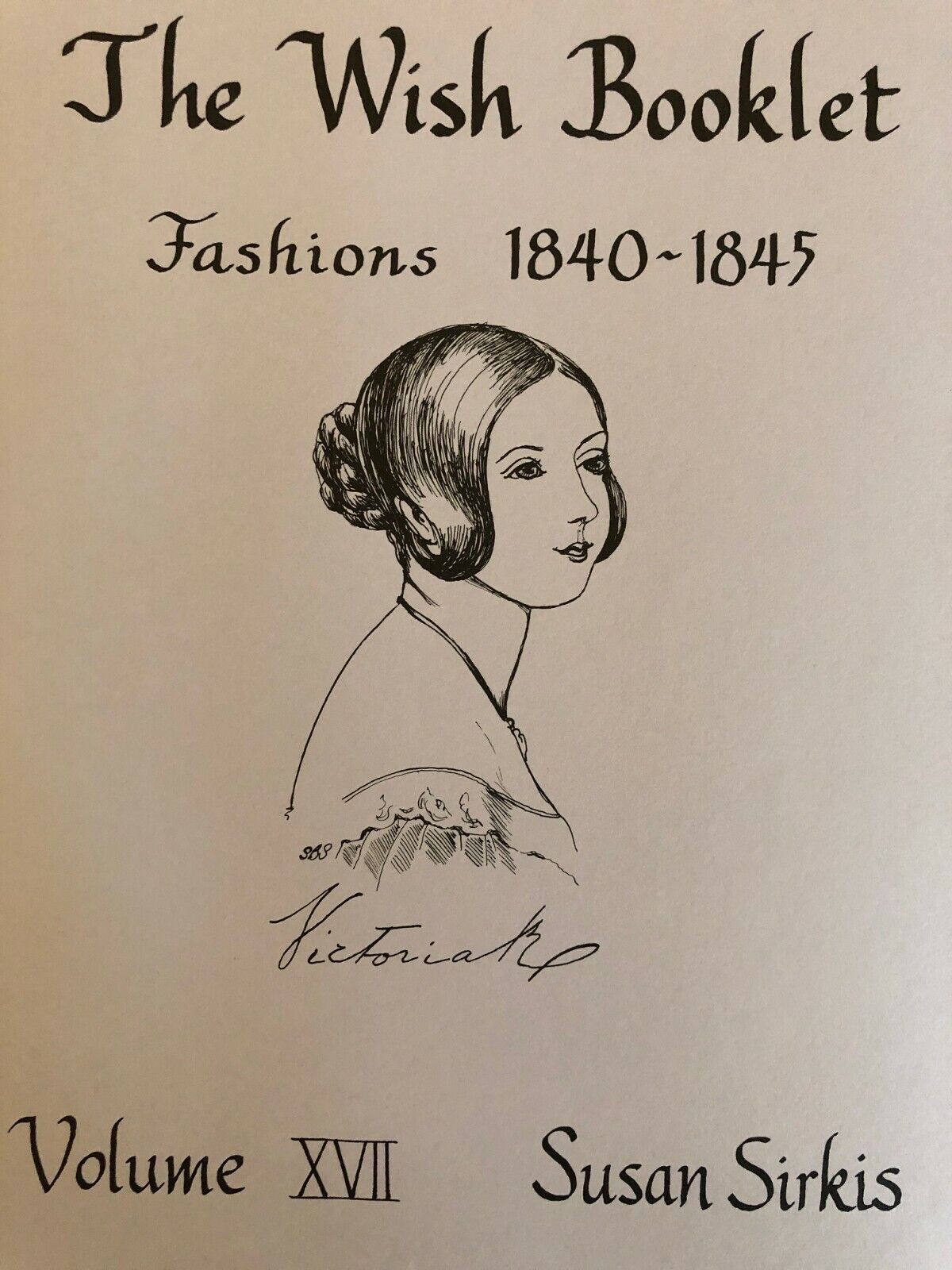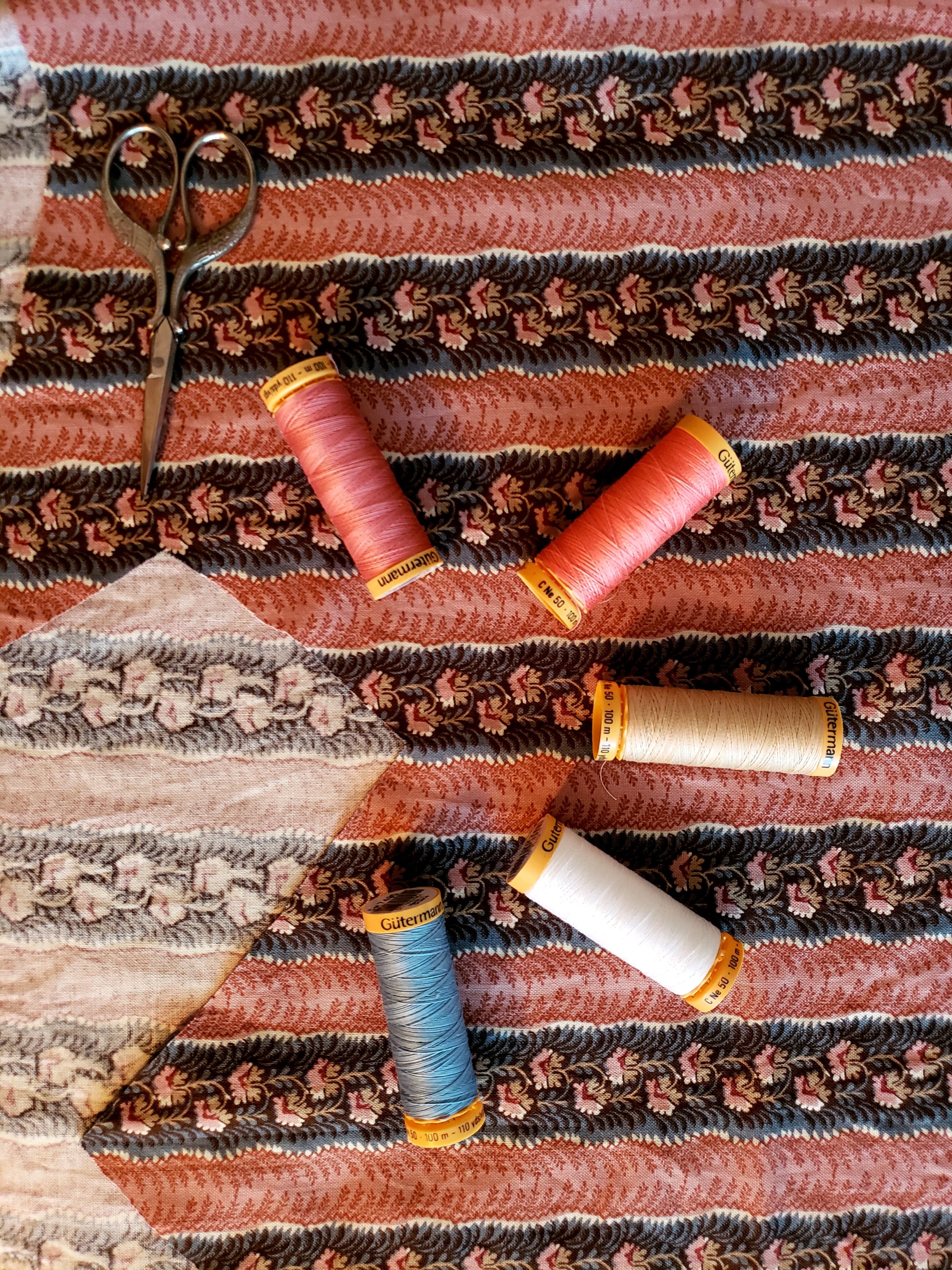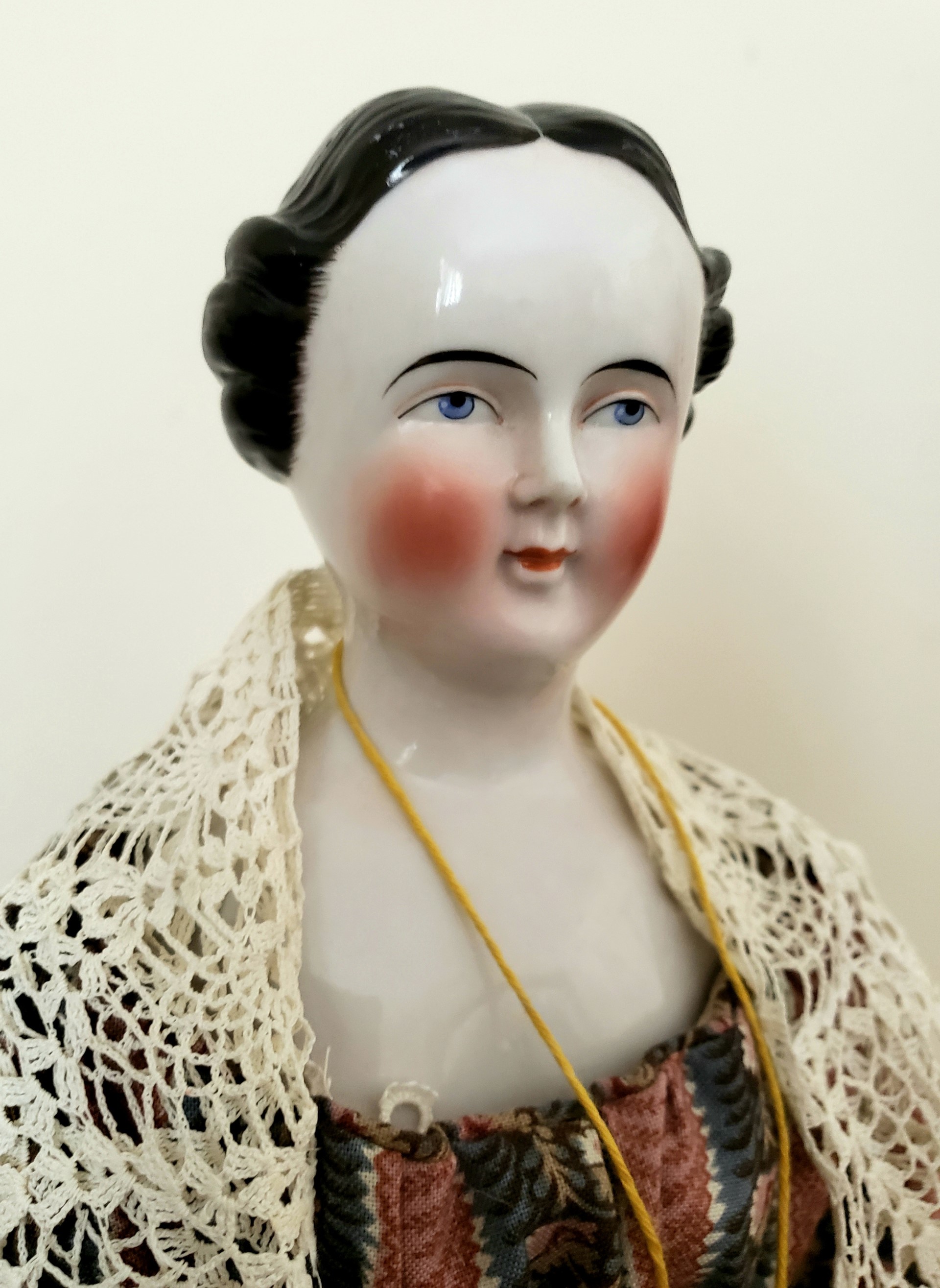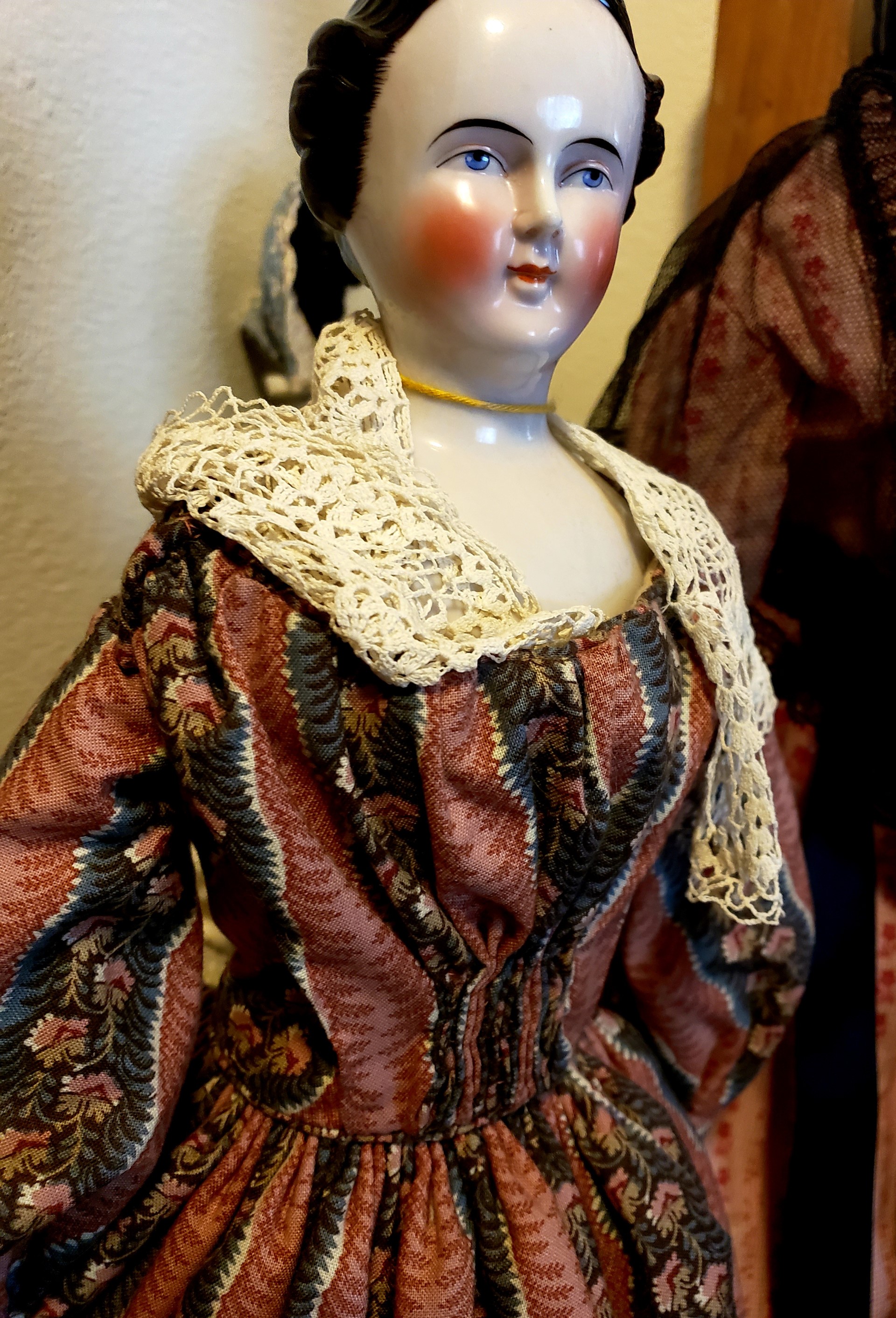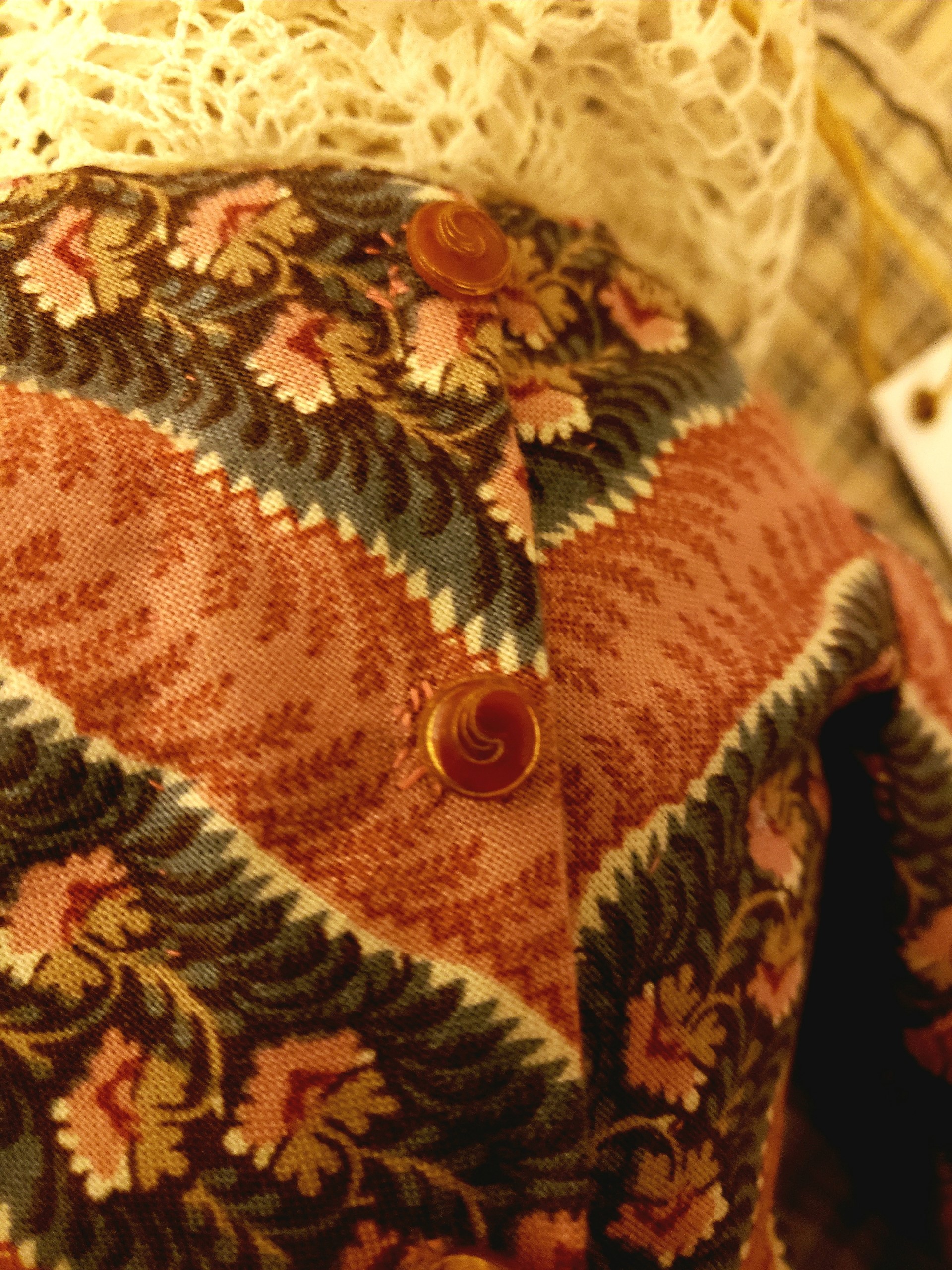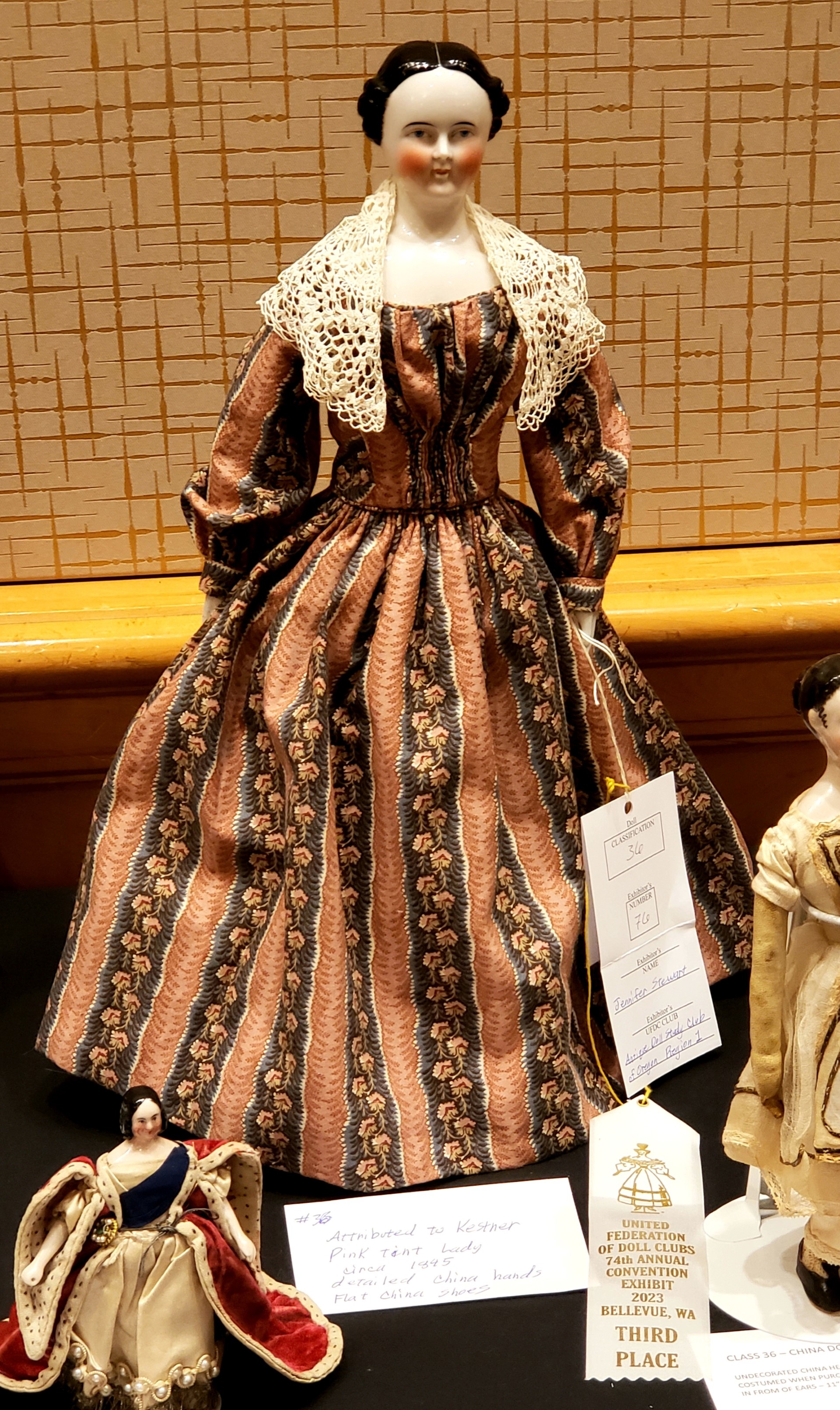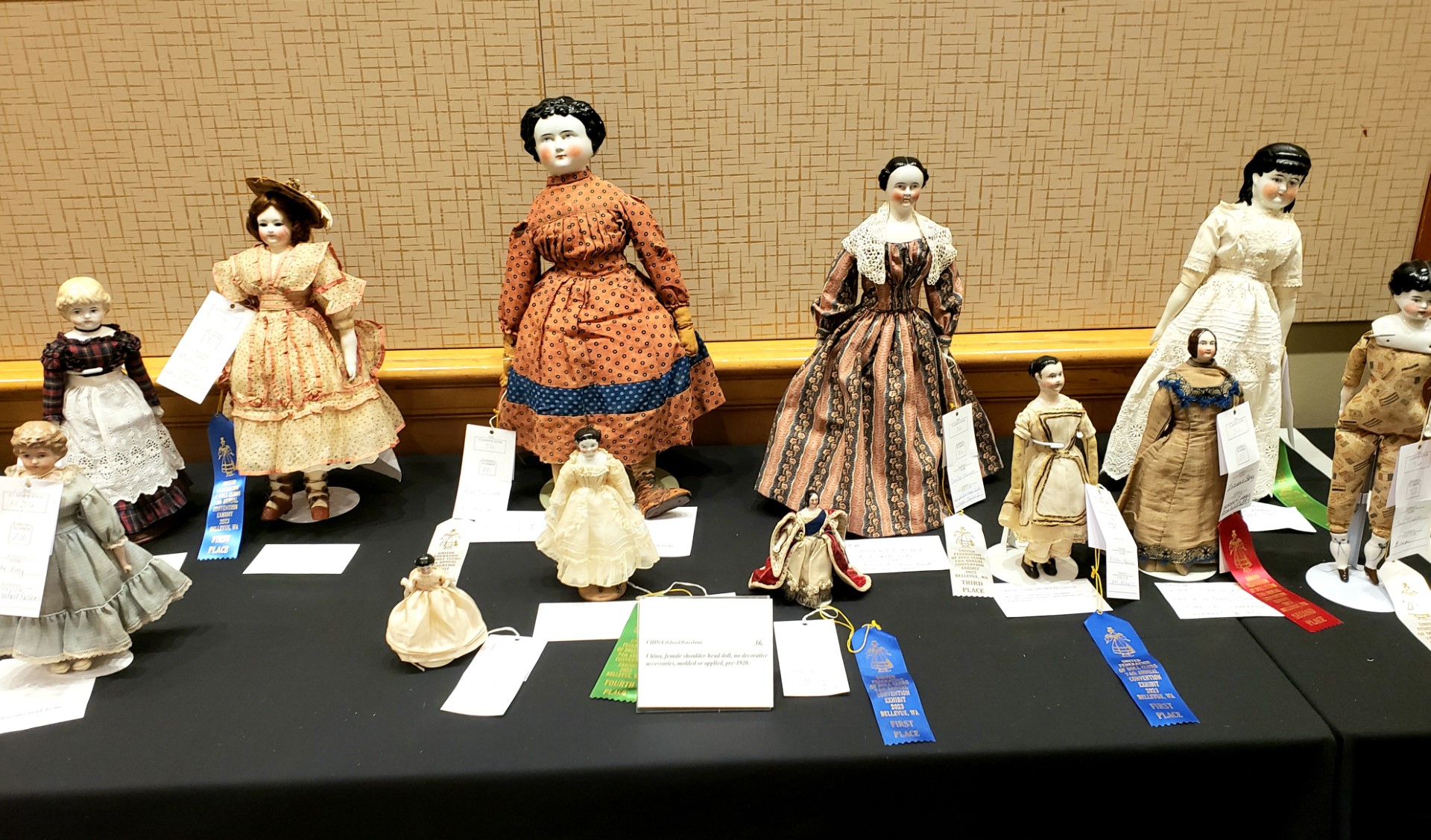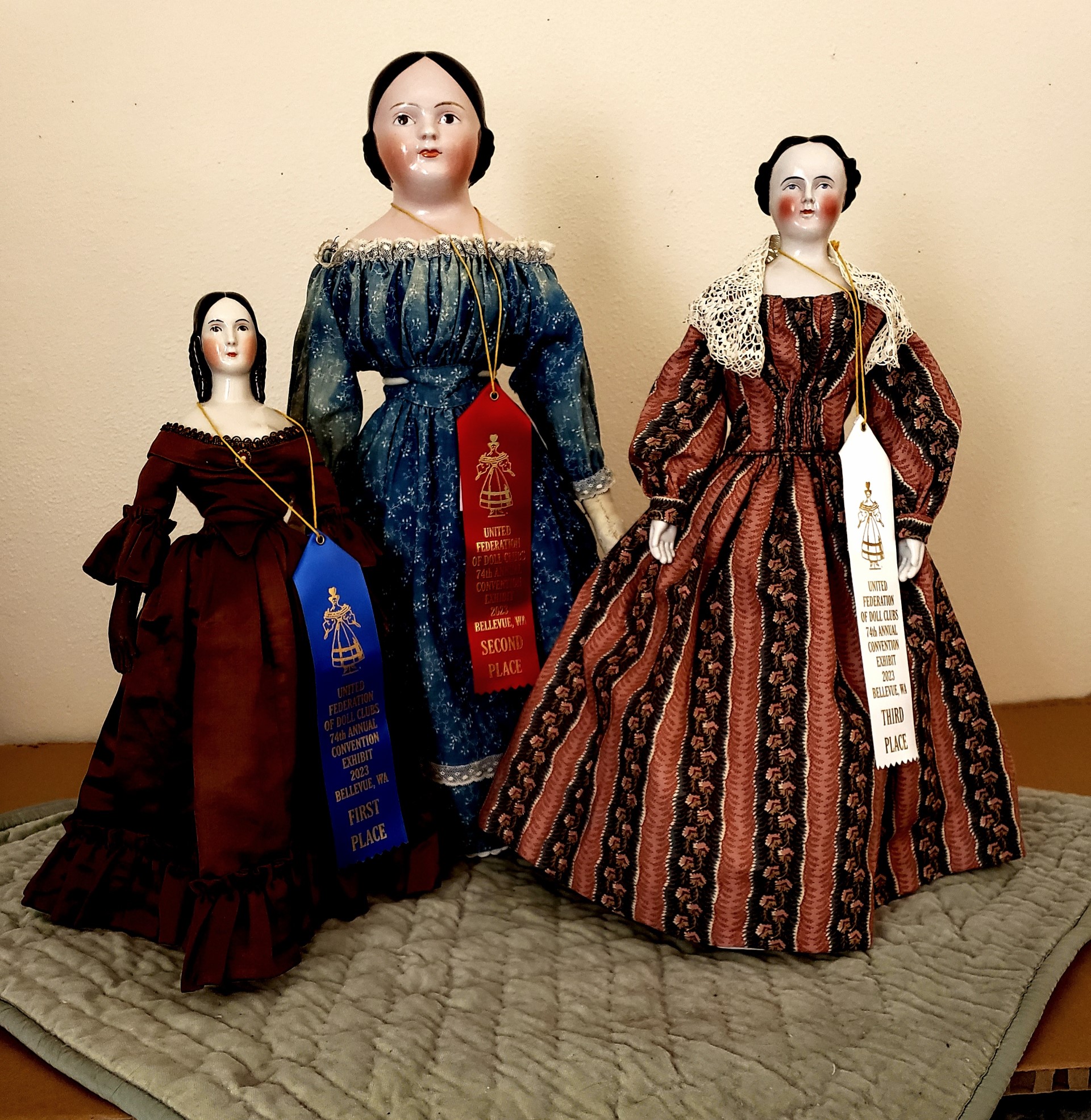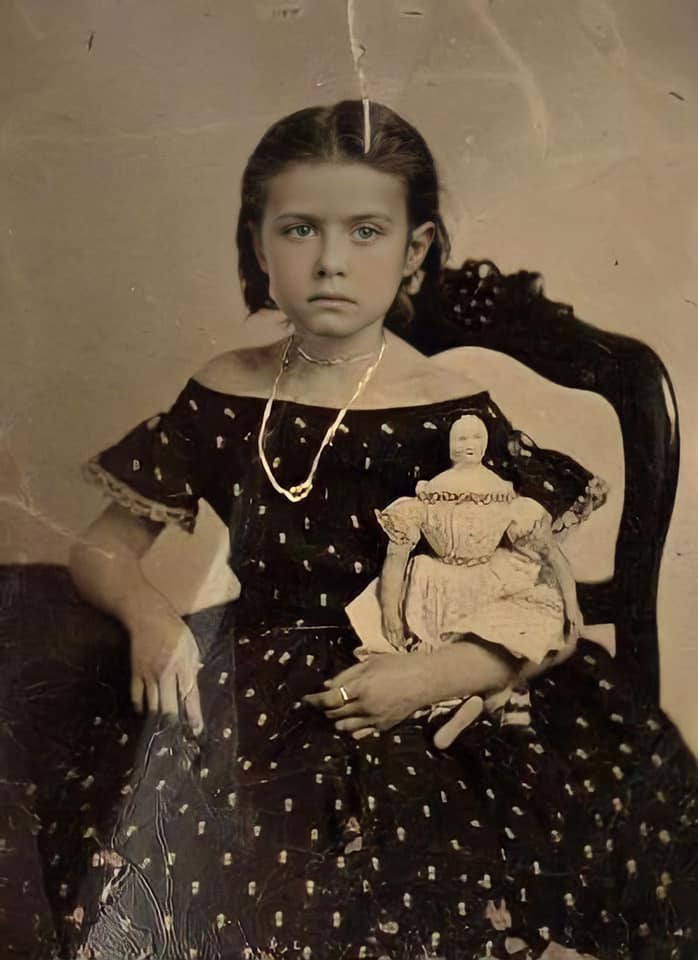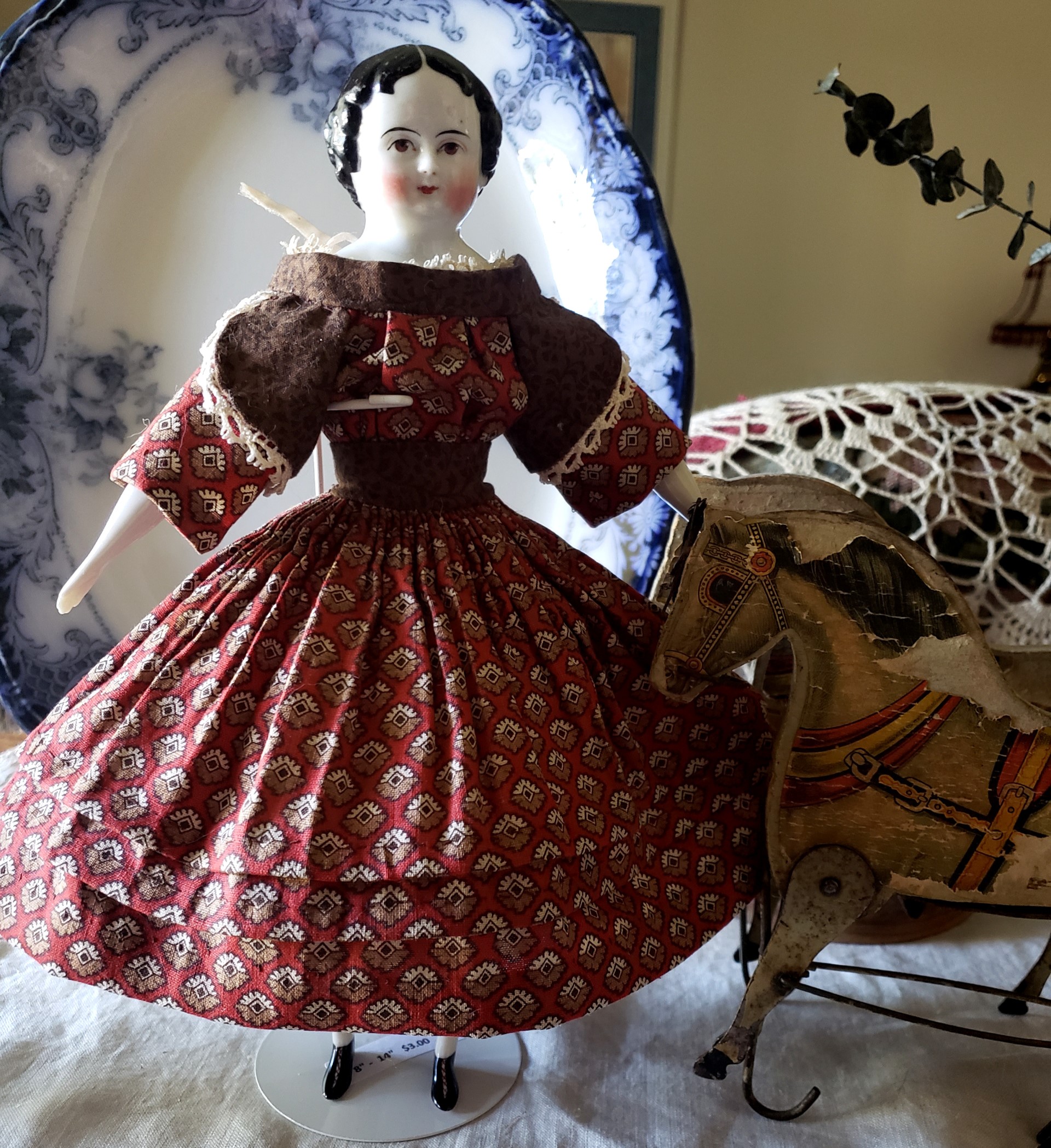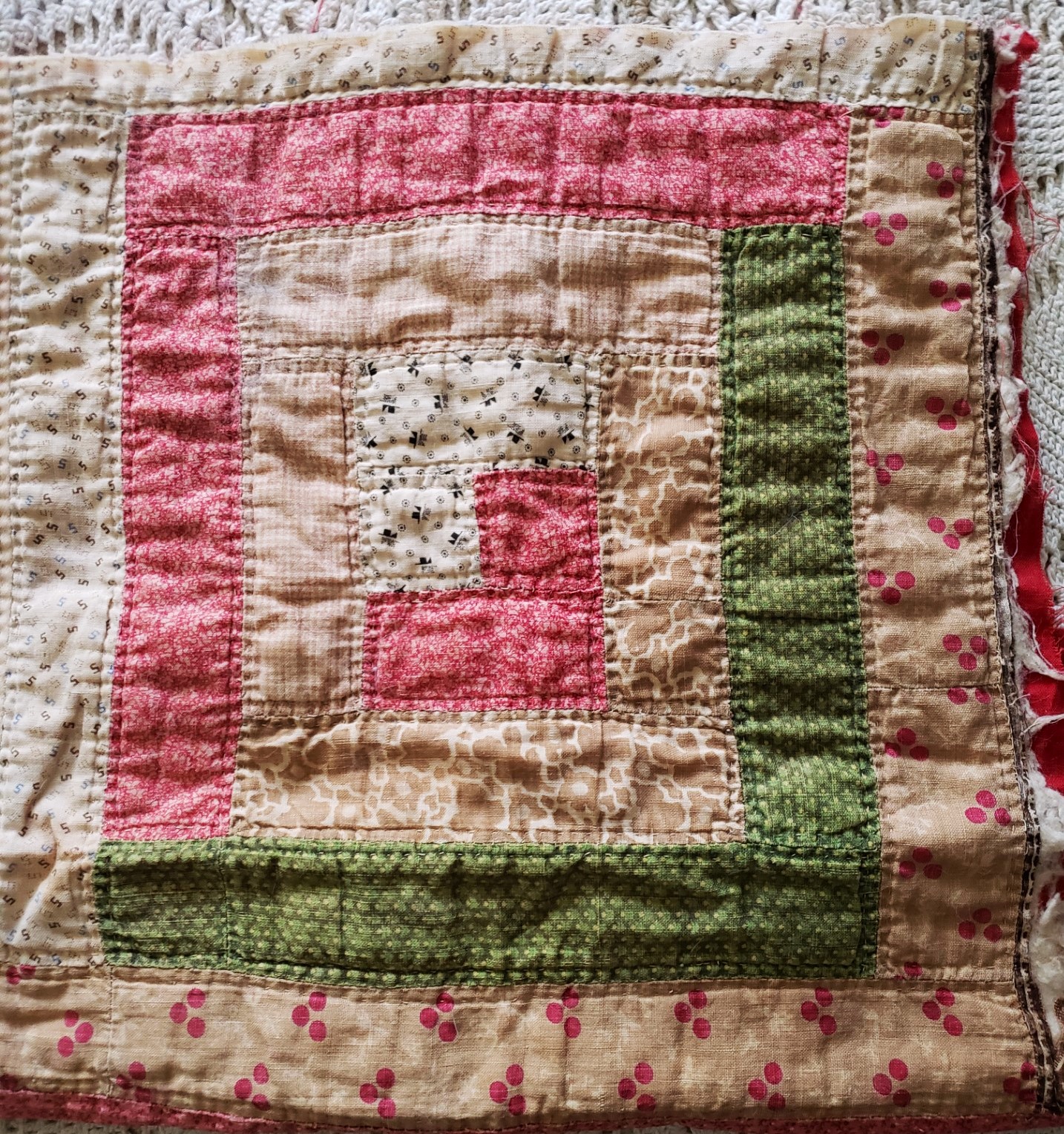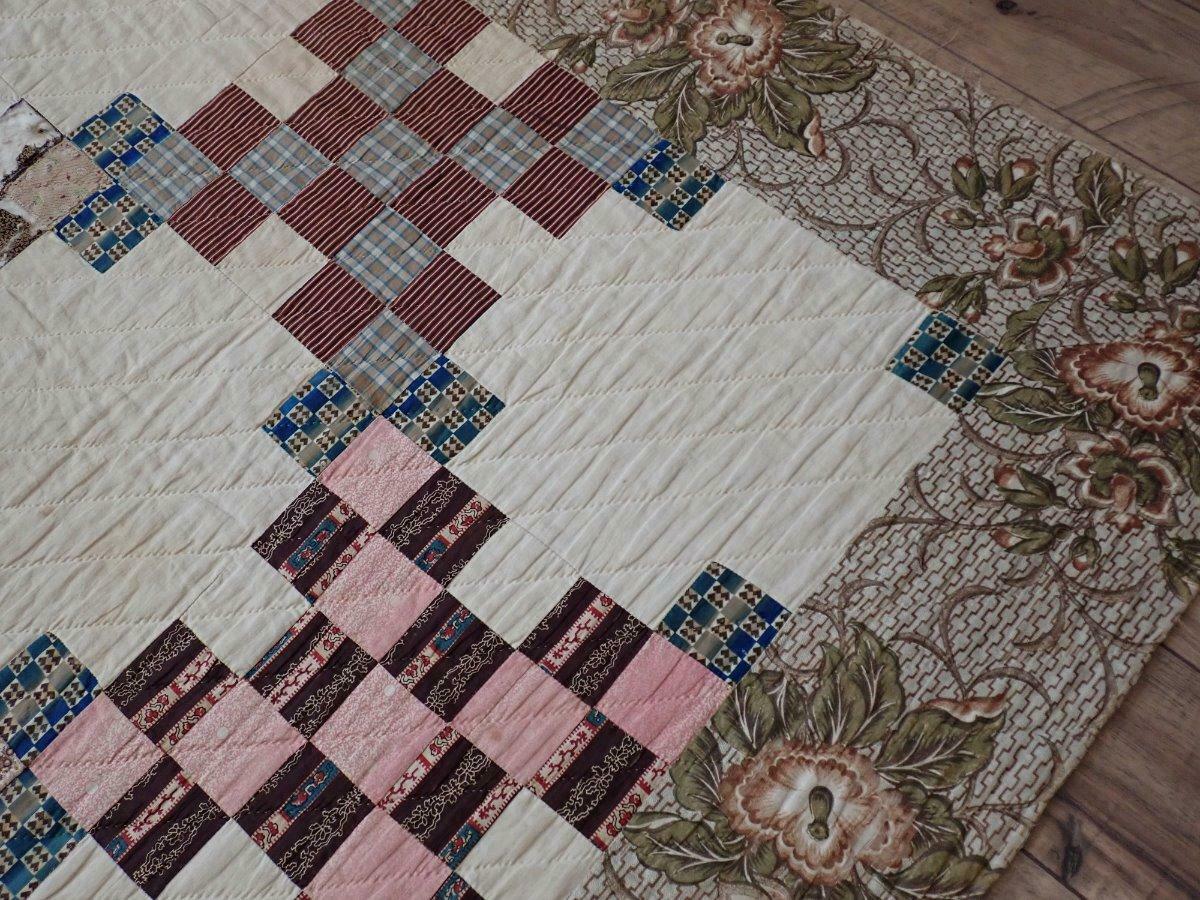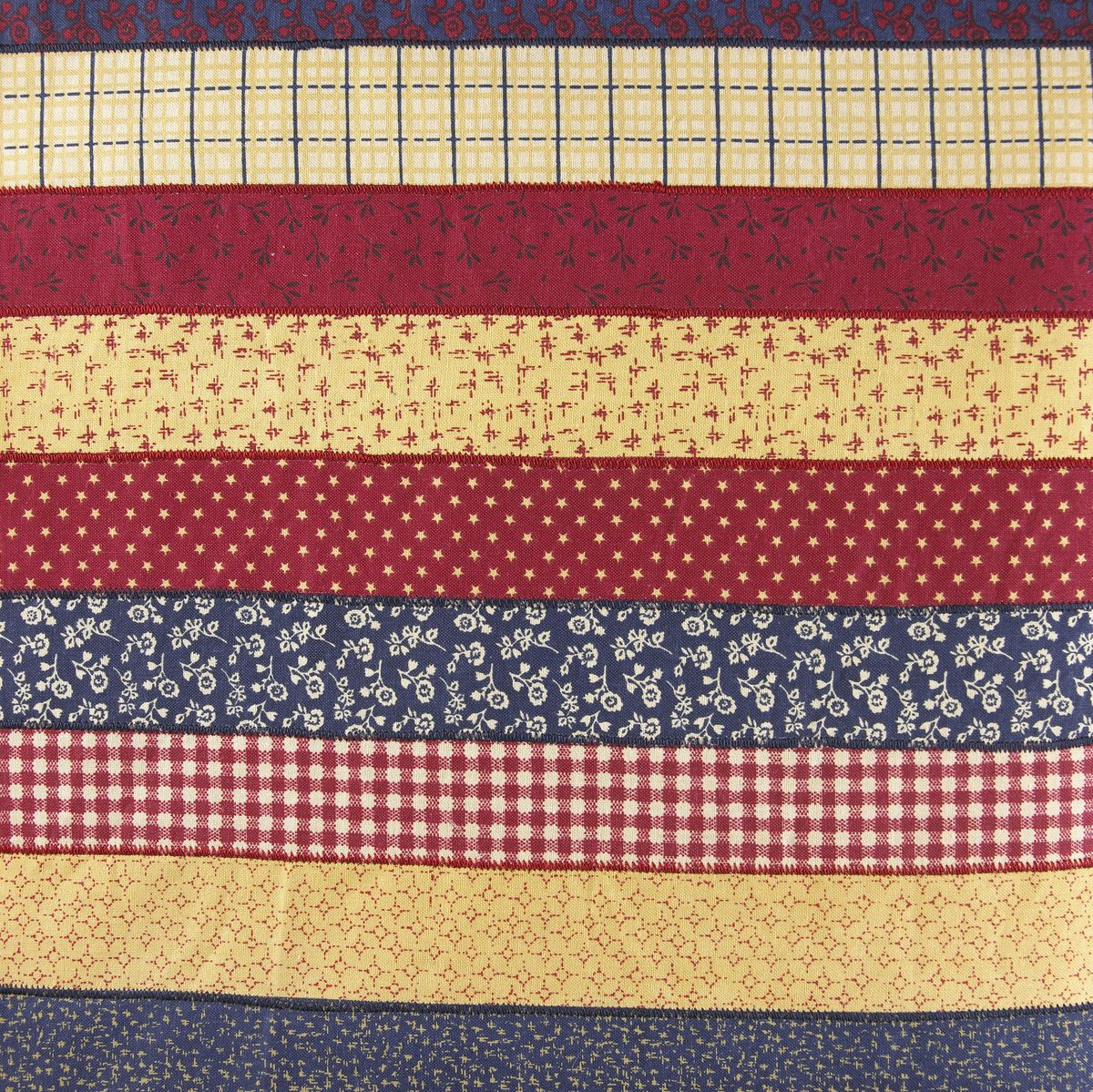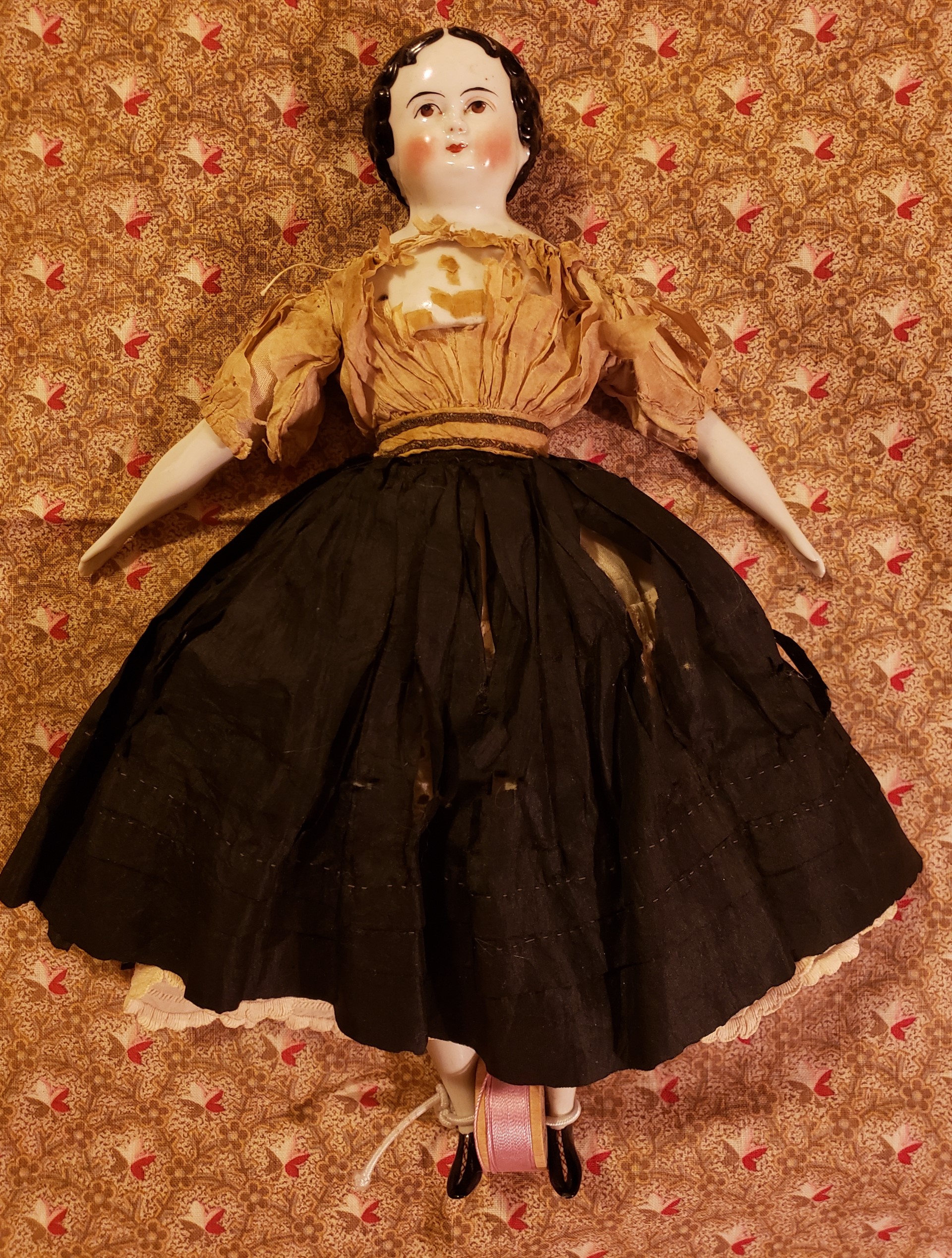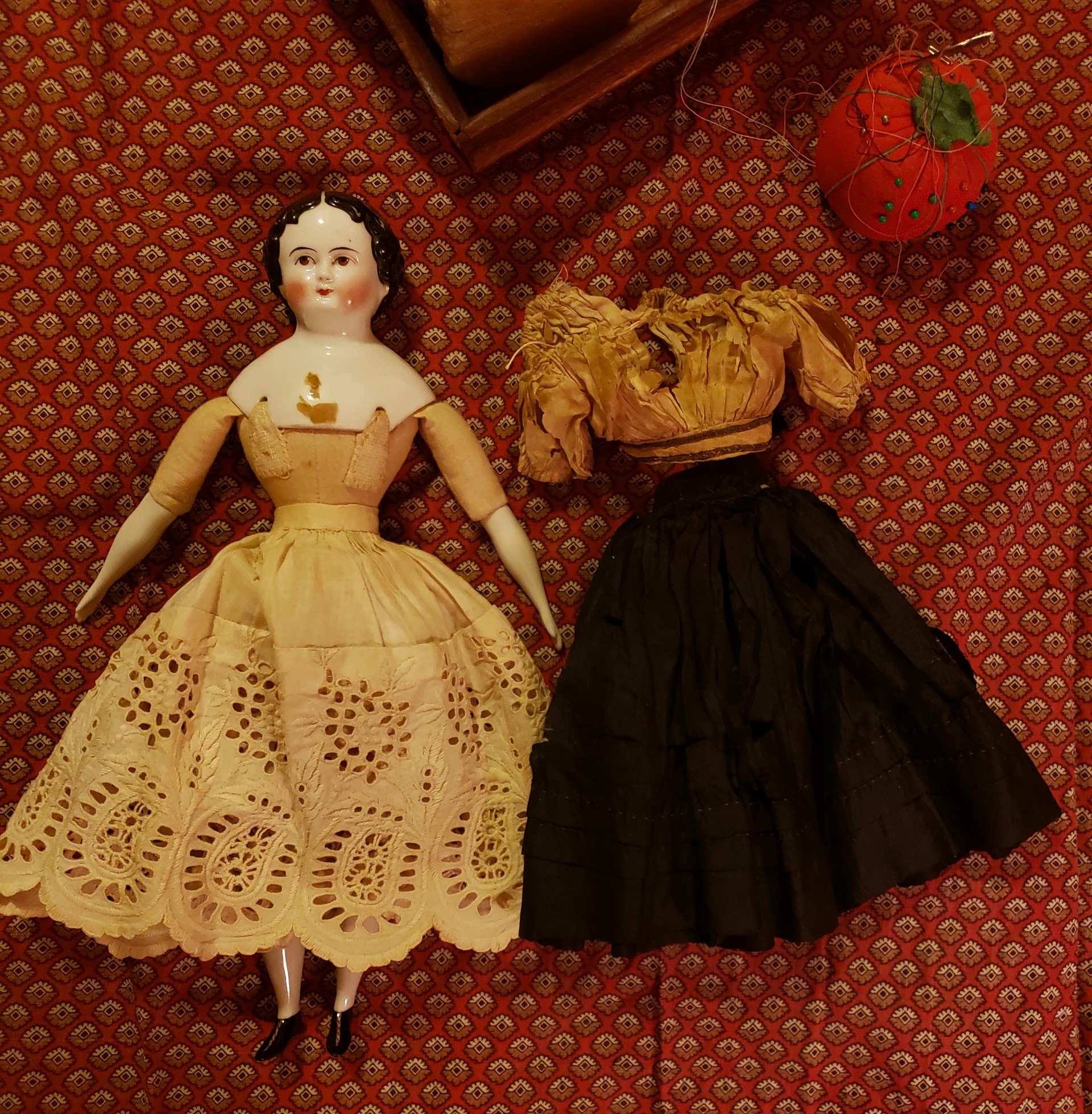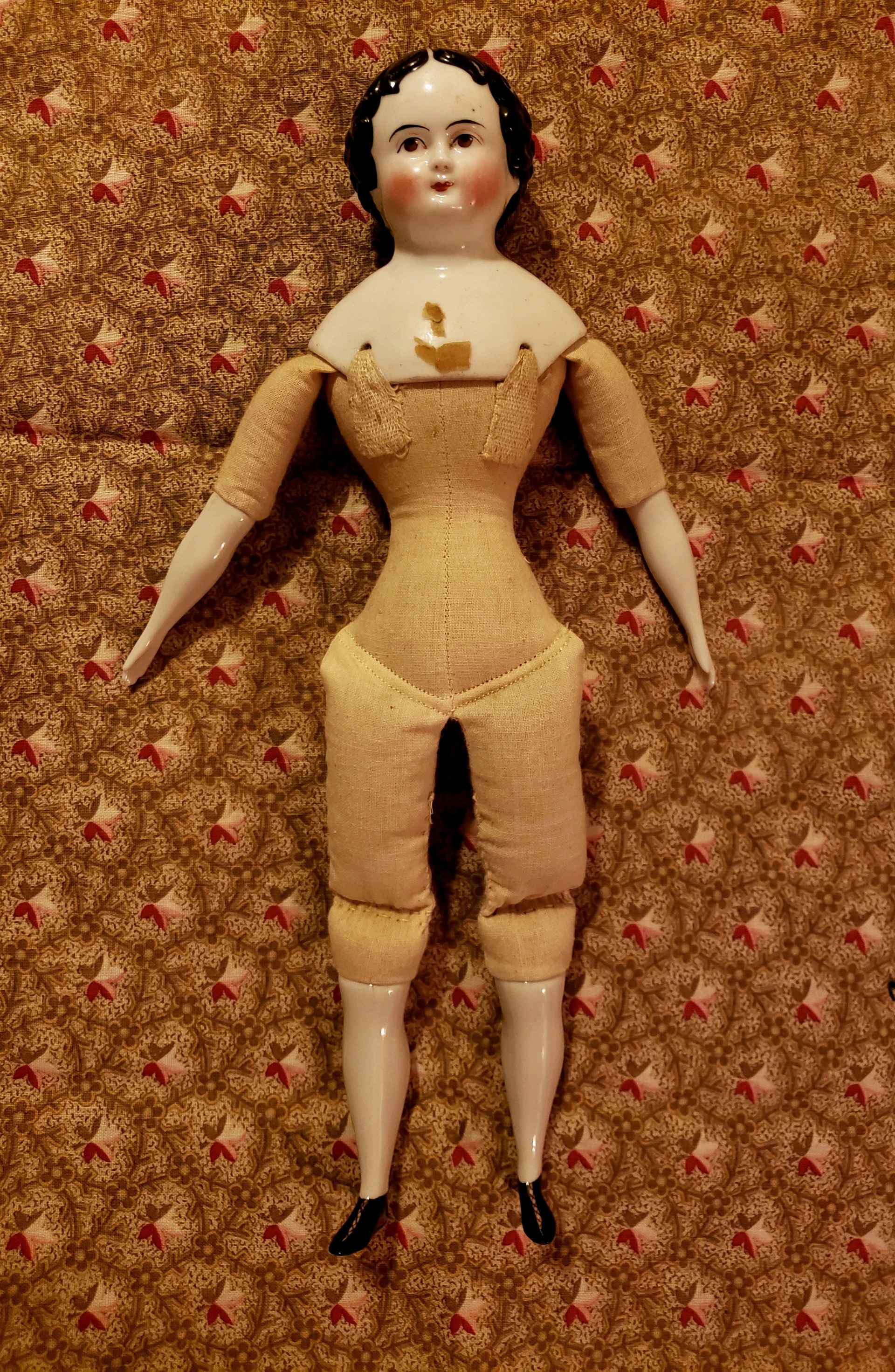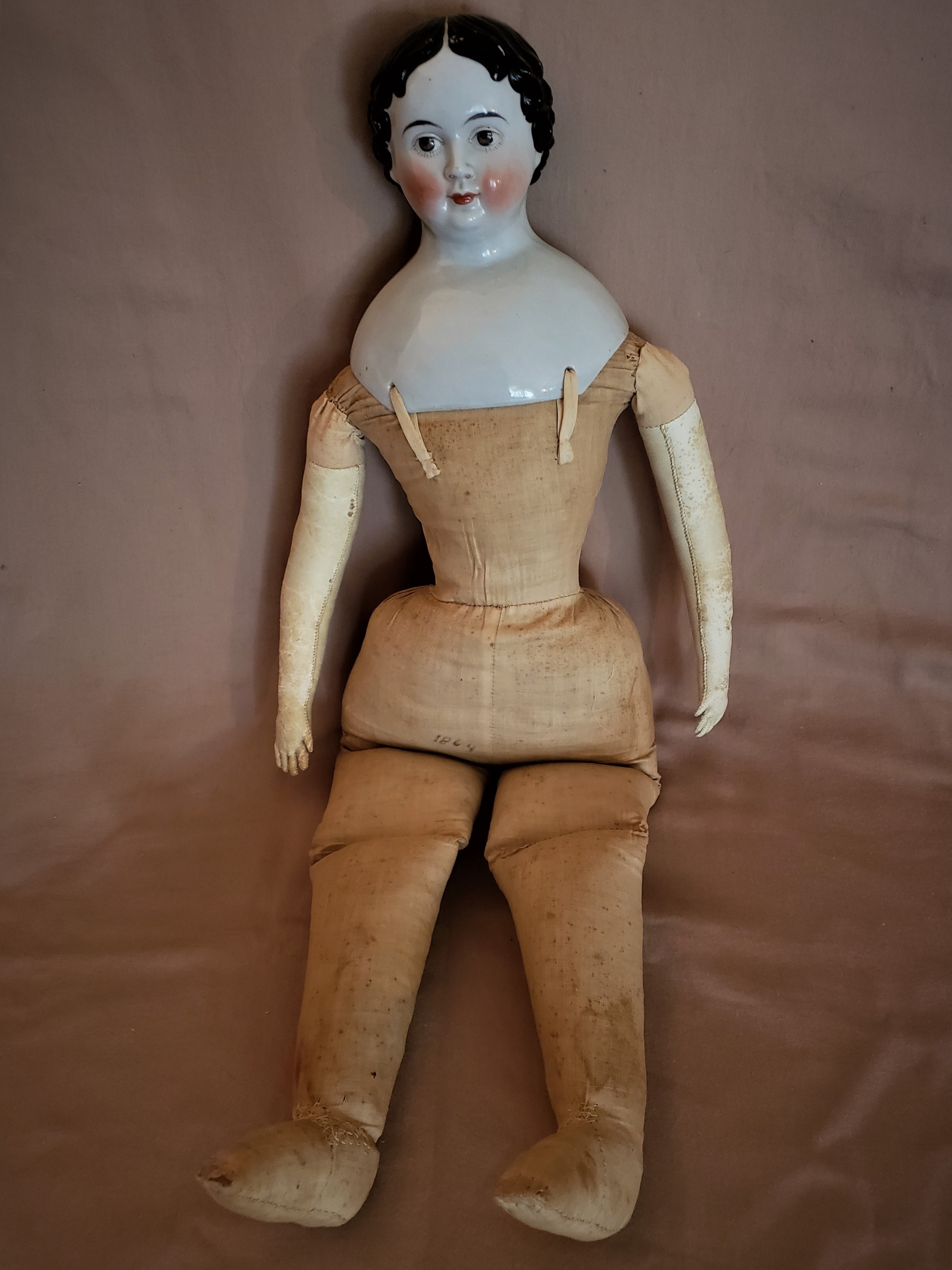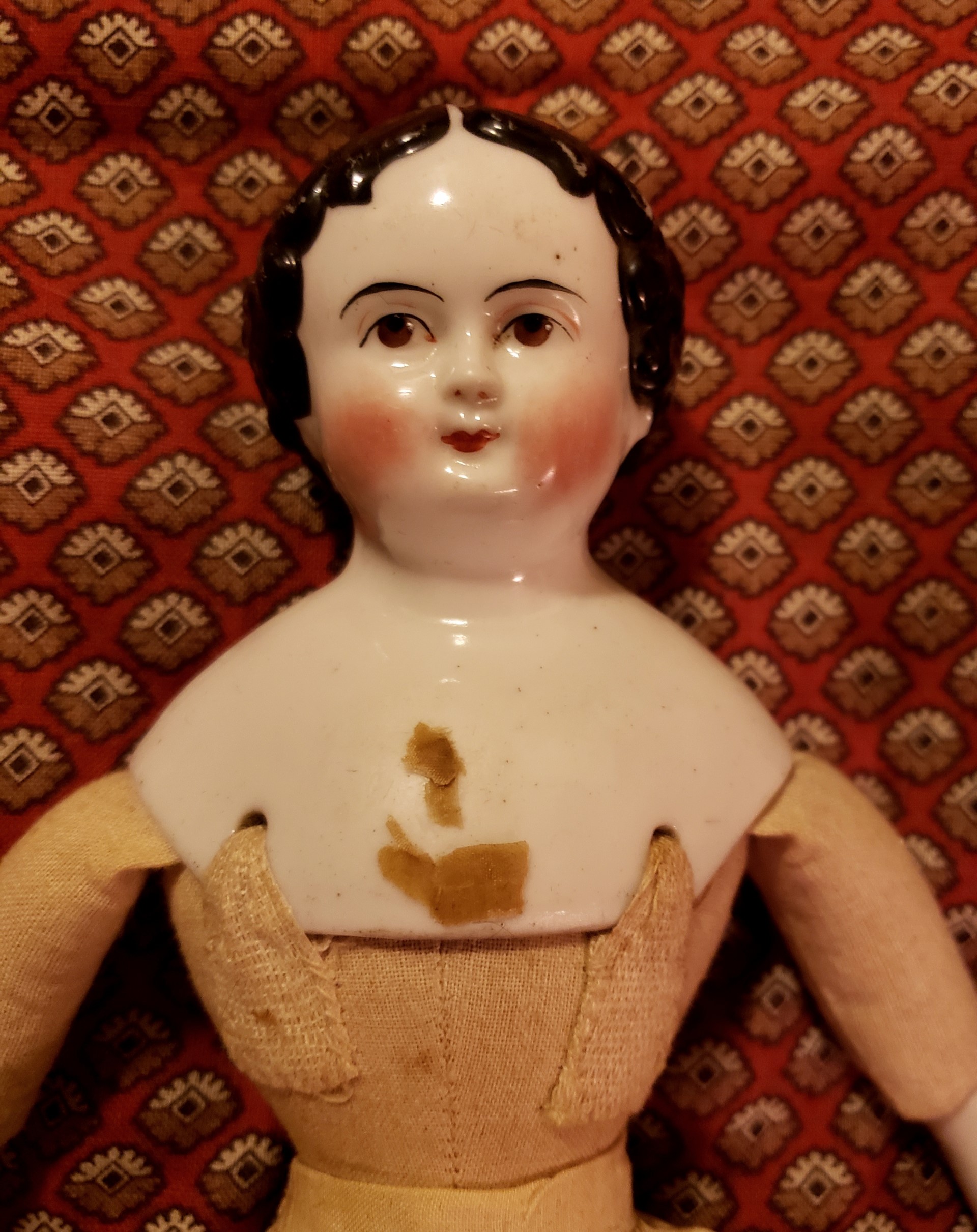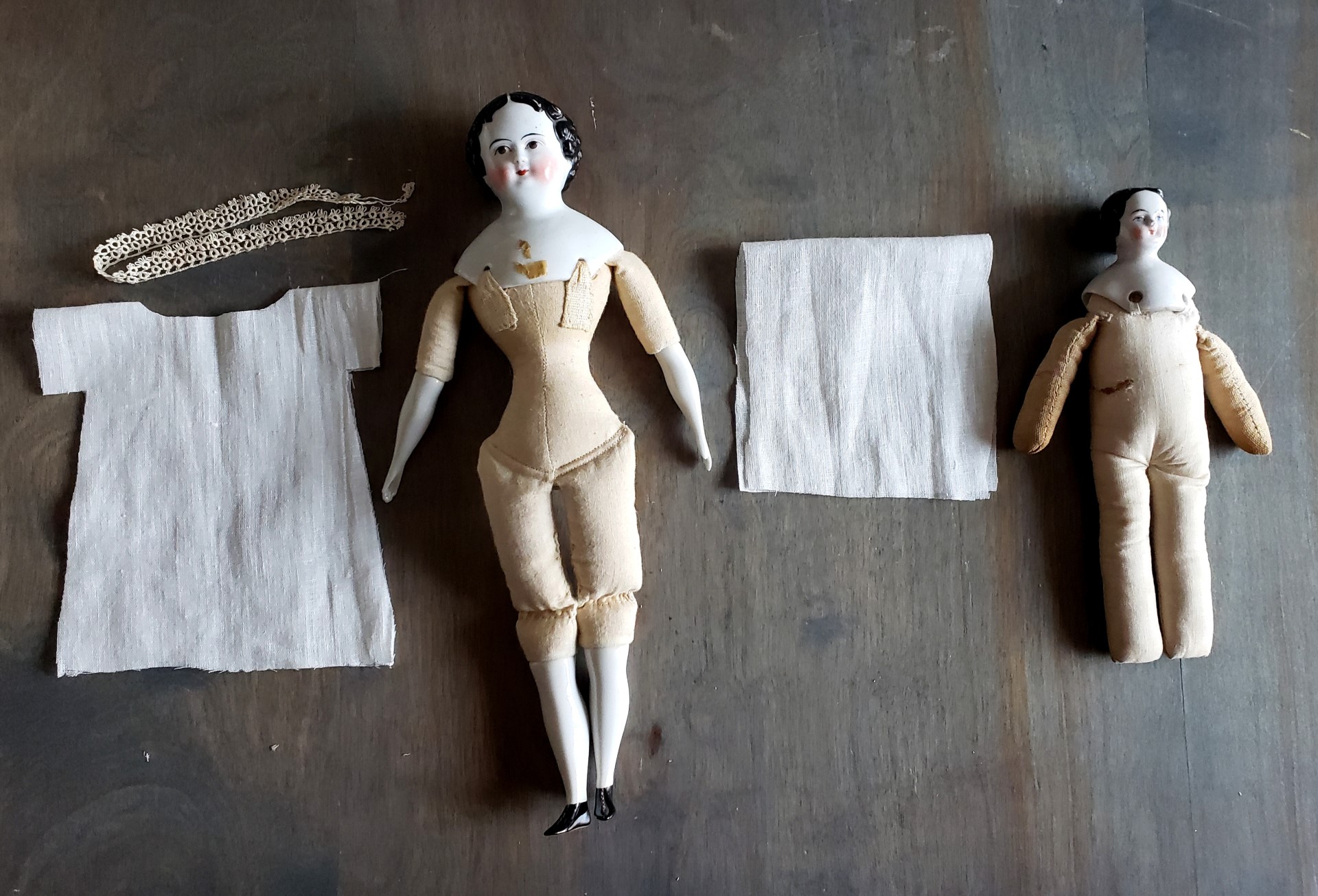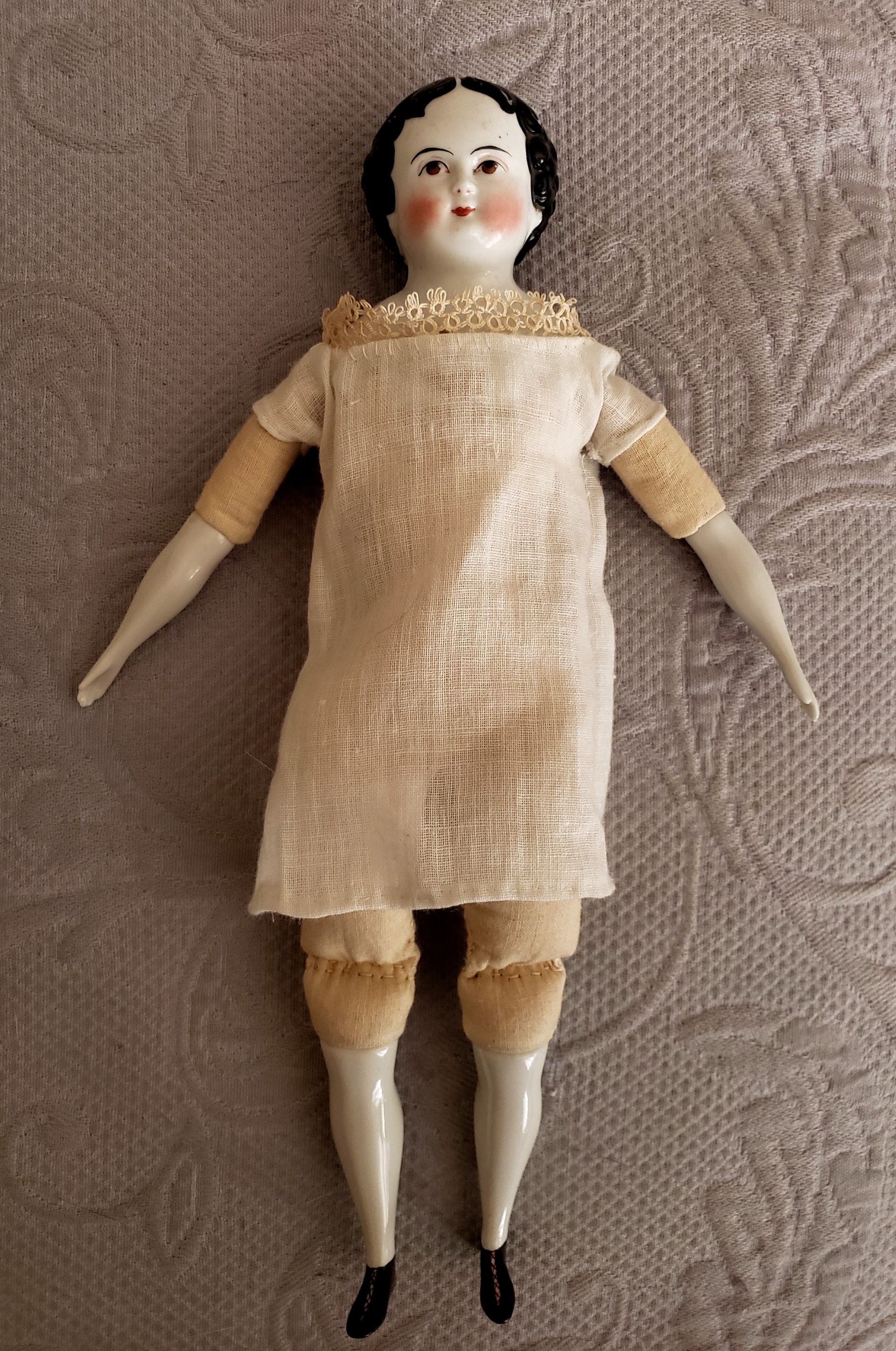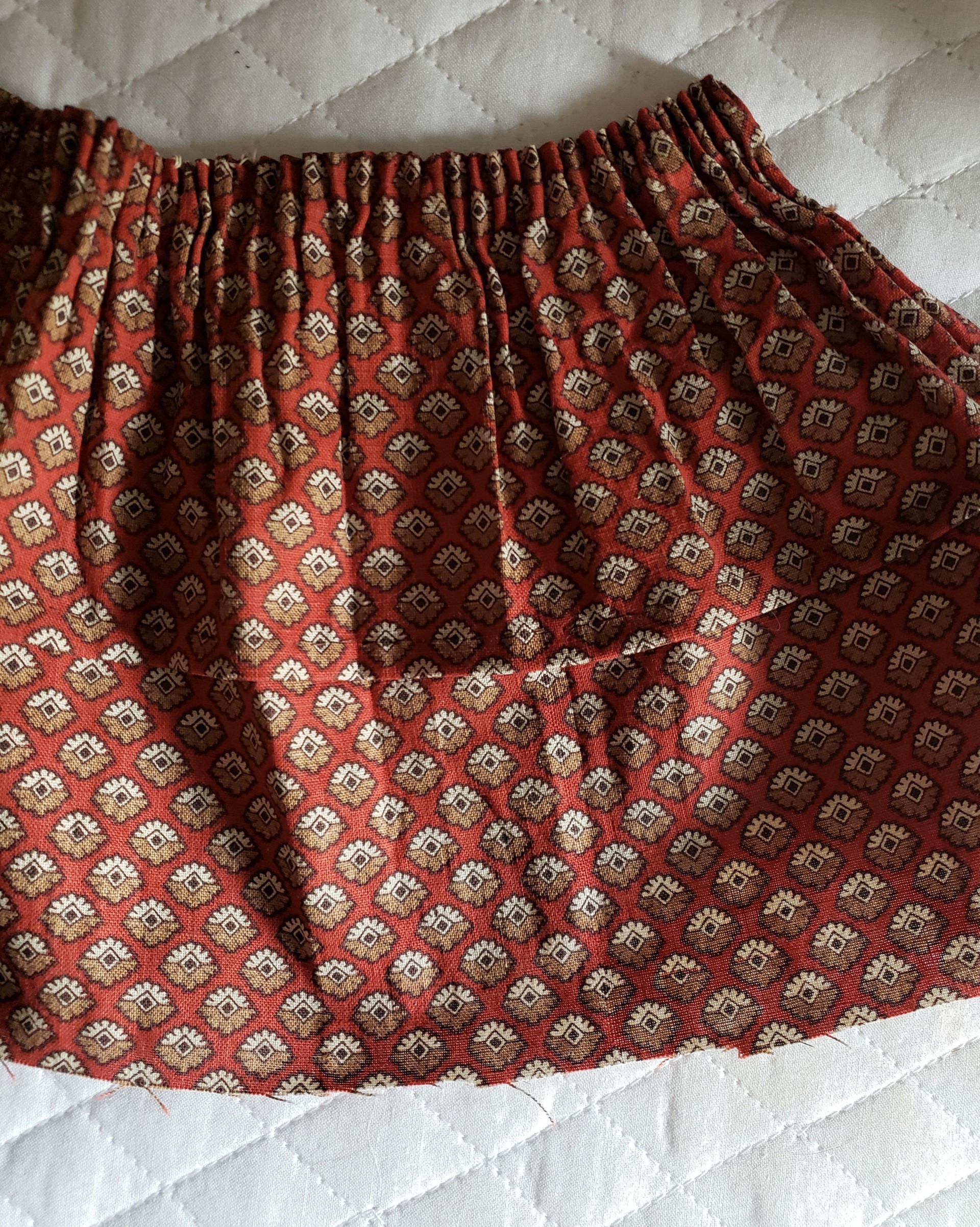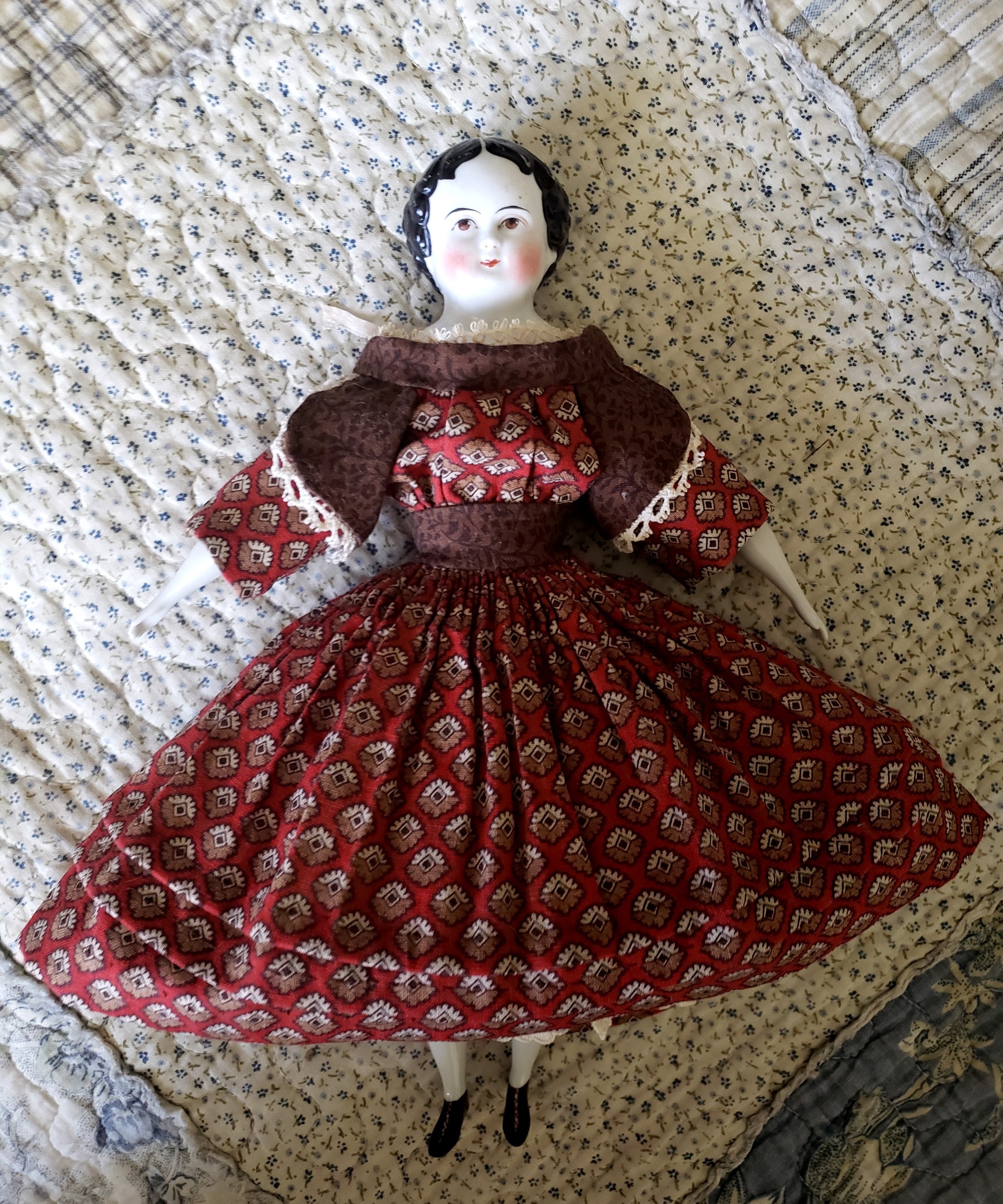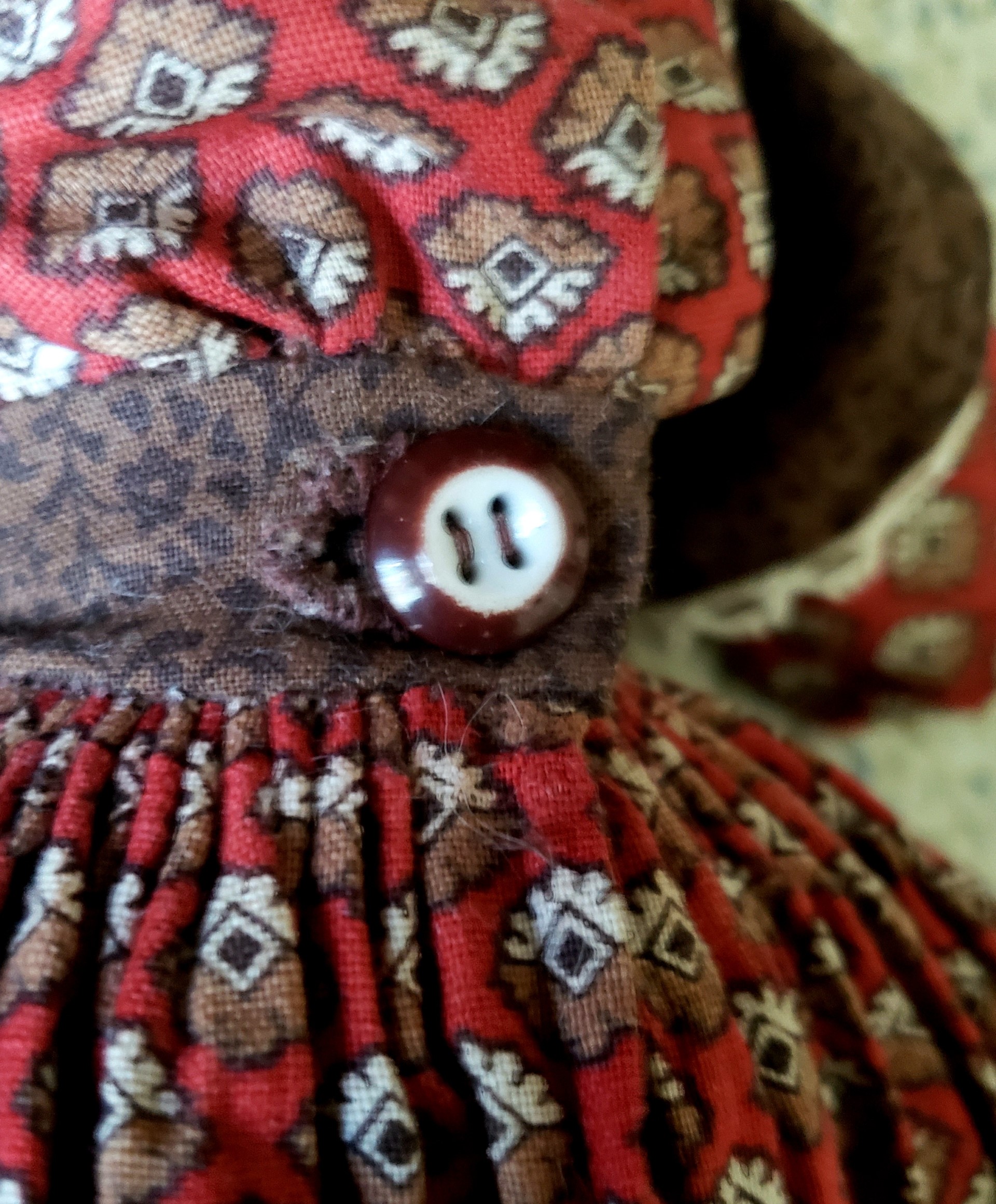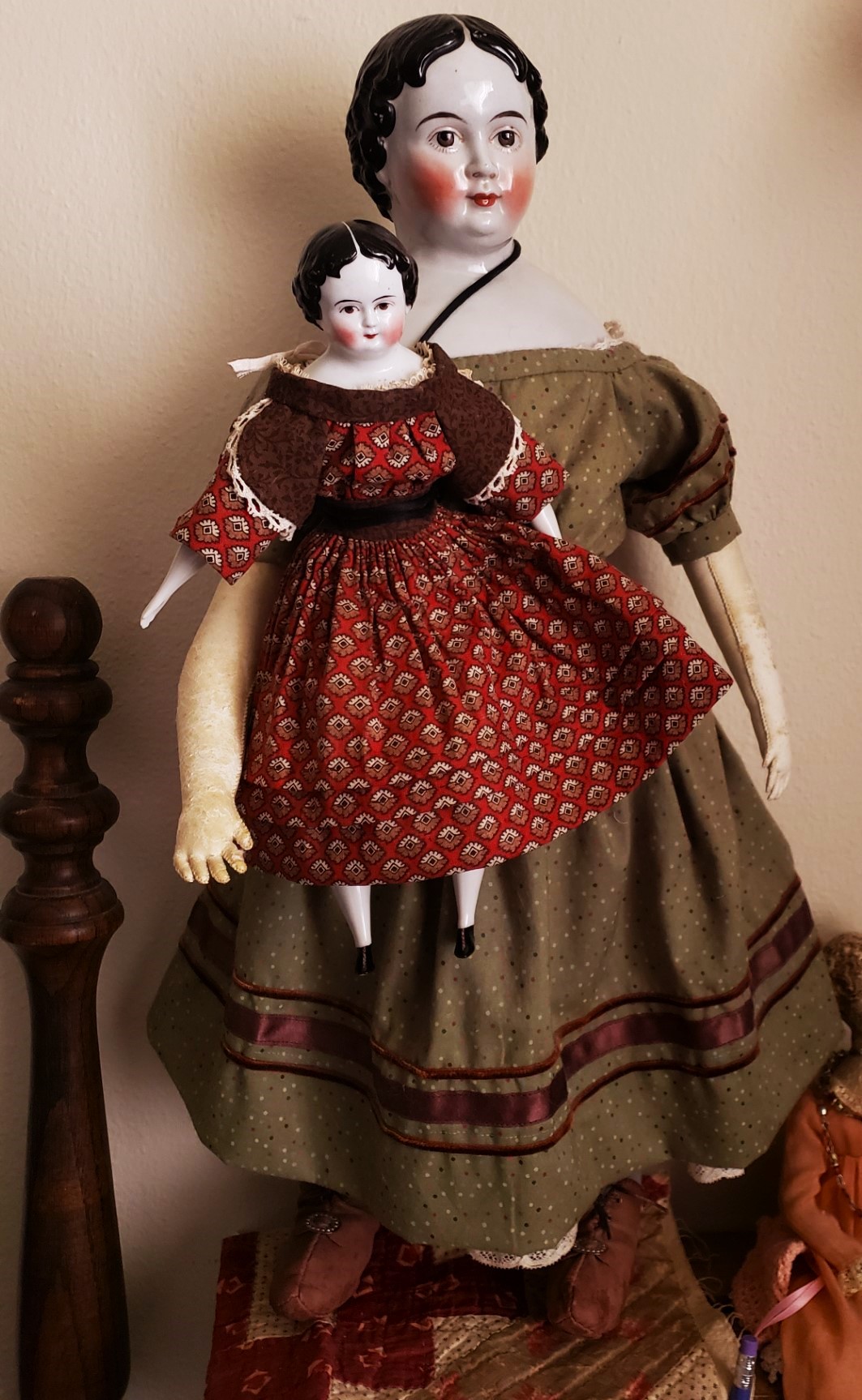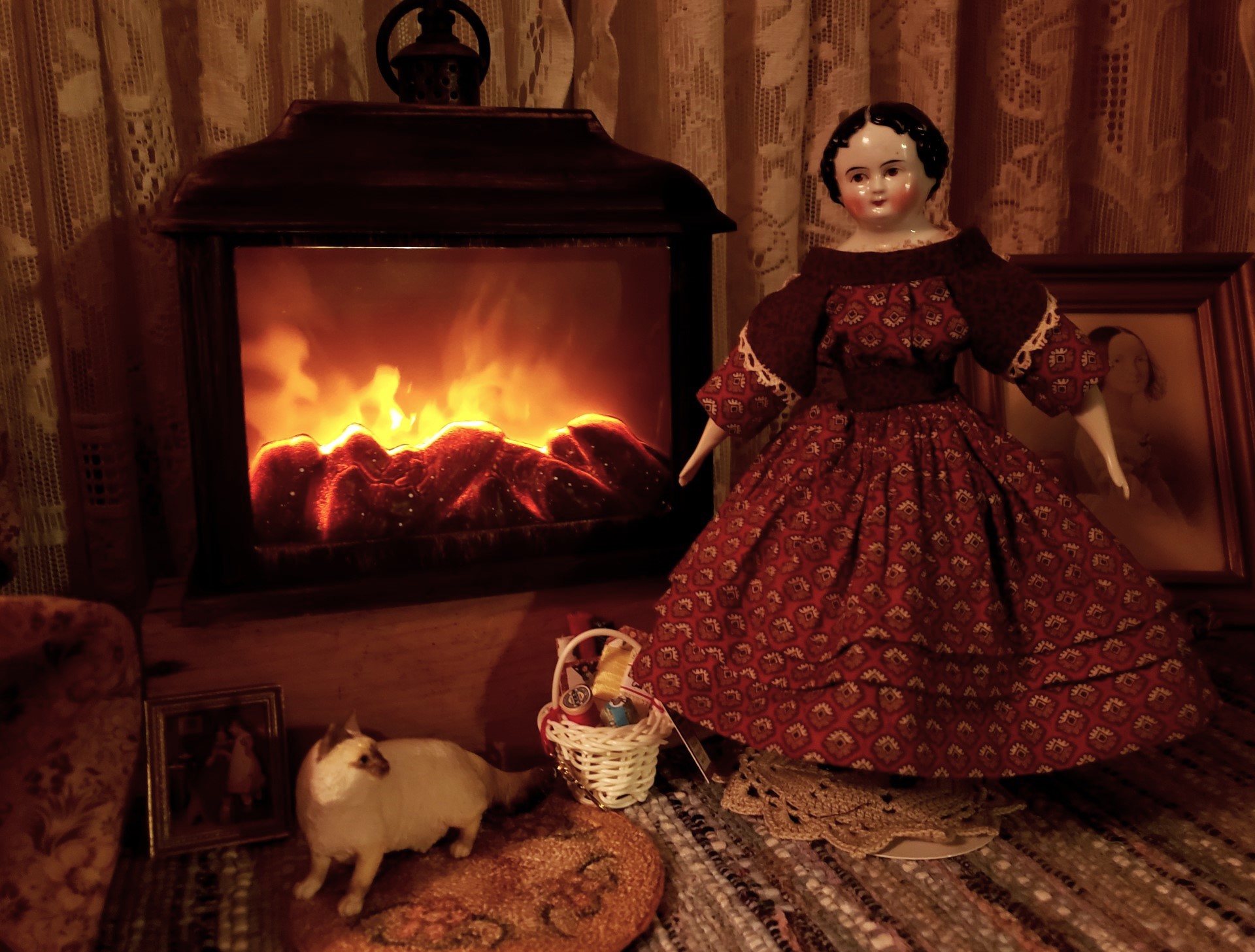What contentment we feel when just the right antique doll comes home to live with us! More often than not, in our time, in order to acquire the doll we want, we have to be willing to accept a less-than-perfect doll, or one who is not dressed to our satisfaction. Mildred Seeley (1918 – 2001), a well respected doll collector, artist, and author, said in her book, Beloved China Dolls, “In my early books, I said one shouldn’t even buy a doll with a hairline crack for investment. Now, in order to get that 160-year-old doll, we have to forgive a shoulder-plate crack or a hairline; there are more and more collectors and the same number of antique dolls. . . . While listening to these young collectors say they cannot find china dolls complete with head, body, limbs, and original clothing, I realized the rules were too harsh.” (Seeley p. 50)

Mary Morgan in her new frock
(Click on each photo to enlarge it, then click the “back” button on your browser to return to the blog page.)
Once I find that intriguing china doll that I have been searching for, using Mildred Seeley’s rule of four “D’s” (desire, discipline, determination, dedication), I usually have to find a way to dress her appropriately. Sometimes that means tracking down just the right antique dress, but usually for me, with my limited budget, interest in history, and love of sewing, it means researching and creating a costume that is just right for the doll. That is what happened with this Highland Mary china doll.
When I began viewing china dolls in museums, many years ago, I was intrigued by the name “Highland Mary” because of the song, “Sweet Highland Mary,” featured in my beloved “Little House” books by Laura Ingalls Wilder. Many Highland Mary china dolls have blonde hair like Laura’s sister, Mary. I don’t know how this particular type of china shoulder-head doll came to have the name bestowed upon her, or him, as the case may be. Their defining features are that they are German-made child dolls with bangs and short hair with curls, first created in the 1880’s. They are just lovely, and beg to be cuddled, with their innocent childish countenance.

That sweet, sweet face! Notice the eye details, and the new sew-hole tabs
The Doll
After buying my first antique china doll in an antique shop in Connecticut, I began searching eBay for Highland Mary dolls because this was my dream china doll. The acquisition of this doll has a bit of a story. The first time I went on e-bay and searched antique china dolls, I found a beautiful Highland Mary as a buy-it-now with a price tag over $200, which was a big expenditure for my budget. This was late at night, and I decided to sleep on it before I committed to spend so much. Well, next morning when I decided I did want her, she was already sold. I bid on several other Highland Mary types that were smaller, heads only, or not in good condition, and lost those auctions, which is probably just as well, keeping in mind Mildred Seeley’s rules. Then I received an e-mail that another Highland Mary was listed, and when I checked this auction, it was the same type of doll I wanted, and she had already sold as a buy-it-now within a few hours of being listed. I searched for another six weeks before I found another comparable doll, but she was more expensive, and I didn’t think I could justify the price. I let that buy-it-now auction end without bidding. Then, the same doll was re-listed with a discounted price. I decided to get my Highland Mary, even though she was more expensive than the first one. That one had a cracked shoulder plate, and mine has perfect china, so I think the price is justified, and I am so happy she is here with me!
My doll, Mary Morgan, is a 21” German antique china shoulder-head doll from the Alt, Beck & Gottschalck factory. ABG made dolls from 1854 into the 1930’s at their porcelain factory in Nauendorf, near Ohrdruf, Thuringia, Germany. Her shoulder-head measures 5” high. Mary Morgan has the characteristic face painting of ABG dolls with blue eyes that have a three quarter circle darker outline around the iris, and a white highlight dot to the side of each pupil. She has mold number and size, “1000 #9” incised under the glaze on the back of her shoulder plate, a number that first came into use with ABG in 1890, according to Mary Krombholz in her book, Identifying German Chinas. This doll has a short child’s neck, a shoulder plate with four sew holes, and indents at the underarms to indicate shoulders. She has blonde hair with bangs, and all-over short curls in back.
Her seller, Turn of the Century Antiques, Denver, CO, who seems to be quite knowledgeable about antique dolls, called her body “one of those well made ones from the 1950s.” Though not original to the china parts, it is older than I am. It is very firm, stuffed with sawdust. It has the wonderful wood smell of antique house, and reminds me of the museum just down the street from where I once lived in Indiana. Mary Morgan’s china hands are C shaped, and like her high heeled boots with the V-shaped top, they are correct for ABG dolls of this time period. When she came to me, her shoulder-head was sewn to her body with thread through the sew holes, and her head wobbled. I replaced the thread with vintage cotton seam binding tabs sewn onto her body, and now her head sits more firmly.

The blue raw silk 1860’s frock
The Frock
Mary Morgan came dressed in a white cotton blouse with elbow length sleeves with lace at neckline and cuffs, and bloomers with elastic waist and legs with lace at the bottom. Putting together an outfit to suit her countenance to the best advantage, using original, antique, and home sewn parts, has been a satisfying venture. To tide her over until her new dress was finished, I bought her a pink 1880-90’s style dress that is new with modern material. Though the style works well for her, the color causes her complexion to fade out, and the modern materials do not work well for her.

Mary Morgan in her modern material 1890’s dress
I researched books on antique dolls and costumes to find the right dress for my doll. I decided on a circa 1860’s frock with narrow black ribbon trim. I found an example of this frock in an auction catalog, What Dolls Wore Before, by Florence Theriault. The original gown was made of light brown linen, and sold at auction in 1997 for $1,100.
Although the original gown that my dress is based on was made two decades before my doll’s time, I decided the style was classic and timeless enough to work for my 1880’s doll. The 1880’s style girls’ dresses with their drop-waist are typically seen on bisque dolls of this time. I wanted a dress style that would work well, both for my china doll’s more shapely figure, and for her stage of development as a young girl. Because this dress has straight lines to its construction, I thought I could copy it without the aid of a pattern.

The Theriault Auction antique linen gown
Blue is the color that I thought would best compliment Mary Morgan’s blonde hair, blue eyes, and pink cheeks. I re-purposed a 1980’s raw silk wrap skirt for the fabric, and chose bleached muslin for the lining rather than the polyester lining material that was in the skirt. The first challenge that I encountered was figuring out what a double box pleat was from the catalog description. On closer examination of the photograph, I could just see one of the double pleats on the side of the original gown, under the sleeve.

The double box pleats toward the back of the skirt
My construction started from the bottom. I lined the skirt, made the wide tuck at the bottom, hemmed it, and hand stitched the black velvet ribbon trim. Next, I attached the pleated skirt to the waistband. The bodice was gathered to the front and back yoke bands, the shoulder straps added, and then the sleeves attached. The ribbon was hand sewn on the different parts at each stage of construction, before the facings were applied. My first attempt at cutting the sleeves did not work. They were too narrow at the top. I re-cut them to resemble those in the photograph better, and made them narrower at the underarm for less bulk there. The sleeves accomplished, I basted the gathered bodice to the waistband and it was time for a fitting!

Hand stitches behind the black velvet ribbon trim

The wrong and right sleeve shapes and the flat sleeve with underarm cutout shape

Basting the sleeve in place
With the fitting, I encountered two problems. The bodice was too long and puckered too much around the doll’s midriff, and the skirt was too long for a young girl’s fashion of the time. It was a simple process to shorten the bodice and re-stitch it. I contemplated accepting the skirt length, but decided it would be worth the extra effort to shorten it for the effect I wanted for this child doll. I could not shorten the skirt at the hem because of the spacing with the wide tuck, so I took it off the waistband, having to partially re-set the pleats, and reattached it. I liked the results much better at the next fitting.

Interior, showing lining and facings
The frock is hand and machine sewn, as would have been the case for a dress constructed in the second half of the 19th century. It is fully lined with facings at the waistband, yoke bands, and sleeves. Exposed seams at the skirt center back and armholes are whip stitched, as would have appeared on dresses made in the 19th century. It closes in the back with four hooks and thread bars. An antique black glass button tops each sleeve, and four similar buttons adorn the back.

The finished sleeve with antique black glass button
The drape of my dress is much softer than the crisp lines and pressed pleats of the original linen dress. The proportions are also not quite the same, yet they are fitted well to my doll. I wanted the skirt to fall below the knee but above the boot top, as is the girl’s style in many Godey’s Lady’s Book illustrations of the 1860’s to 1880’s. Because of the proportions of the doll’s china legs to her fabric legs, the skirt appears long, but falls above her boot top.

My dress has a softer drape and wider proportions than the antique linen dress.
The blouse in which Mary Morgan arrived works well under her frock. I found an antique pair of split drawers with dimity fabric and lace at the bottom for her costume. I also found a child doll’s corset. This corset is made for a leather or composition doll body with a straight waistline, but it fits Mary Morgan’s curved waist by wrapping the bottom ties around and tying them in front so that the back edges overlap slightly at the waist. I made her a petticoat from a lovely batiste remnant that appears to have been an apron or pinafore. It has narrow and wide tucks, and cutwork machine embroidery at the hem in a diamond pattern that compliments the straight lines of the frock.

Mary Morgan in her child’s corset and petticoat made from an antique apron remnant
Our dolls are travelers through time. It may be hard to think about now, but in future years the dolls who live with us now will be passed down to our children and grandchildren, or they will move on to new families, or maybe even museums. Either way, it is our responsibility to the future to document a new costume we create for an antique doll with an attached tag in the dress. Some seamstresses are so skilled at recreating antique techniques that dealers and collectors may not be able to tell the difference between an antique costume and a recreation. I do hope that I will have grandchildren to cherish at least some of my special dolls, and I want to leave a record for them of what I have accomplished. These acid-free paper tags, with a record of the costume I made and the date, are pinned inside of the dress on the antique doll.

Acid-free tags with provenance to pin inside the new dress
Antique dolls that are all original with original antique costumes are a prize to be marveled at. Still, there are many dolls of more humble estate that are worthy of an appropriate wardrobe. When a doll has lost her costume in her travels through time, she can still become fashionably dressed once more with a little research and a needle well plied. I cherish the antique dresses that are a part of my doll collection. Yet, I am proud that some of my antique dolls will carry forth dresses that were created by me just for them.

Mary Morgan loves playing with her wooden toys, but she’s always happy to stop for a moment to show off her new frock!
Bibliography:
Krombholz, Mary Gorham. Identifying German Chinas 1840s – 1930s. Grantsville, MD: Hobby House Press, Inc., 2004.
Seeley, Mildred. Beloved China Dolls. Livonia, MI: Scott Publications, 1996.
Theriault, Florence. What Dolls Wore Before: Doll Costumes and Accessories, 1850 – 1910. Annapolis, MD: Theriault’s Gold Horse Publishing, 1997.
Wilder, Laura Ingalls. By the Shores of Silver Lake. New York: Harper & Row, 1939.
About the author:
Jennifer fell in love with antique dolls at the age of four, after a brief encounter of viewing and holding antique bisque dolls at a home she was visiting. She has collected dolls and sewn for them ever since. Once she discovered her grandmother’s childhood lowbrow china, antique china dolls have been her first love in doll collecting. Jennifer currently lives in a small apartment in Portland, Oregon with her teenage daughter. Their dolls vie for space and keep them company as they display their wardrobes or wait patiently for an appropriate new dress.

